Abstract
We review the experimental evidence for various shapes of dose-response relationships for carcinogens and summarize those experiments that give the most information on relatively low doses. A brief review of some models is given to illustrate the shapes of dose-response curve expected from them. Our major interest is in the use of dose-response relationships to estimate risks to humans at low doses, and so we pay special attention to experimentally observed and theoretically expected nonlinearities. There are few experimental examples of nonlinear dose-response relations in humans, but this may simply be due to the limitations in the data. The several examples in rodents, even though for high dose data, suggest that nonlinearity is common. In some cases such nonlinearities may be rationalized on the basis of the pharmacokinetics of the test compound or its metabolites.
Full text
PDF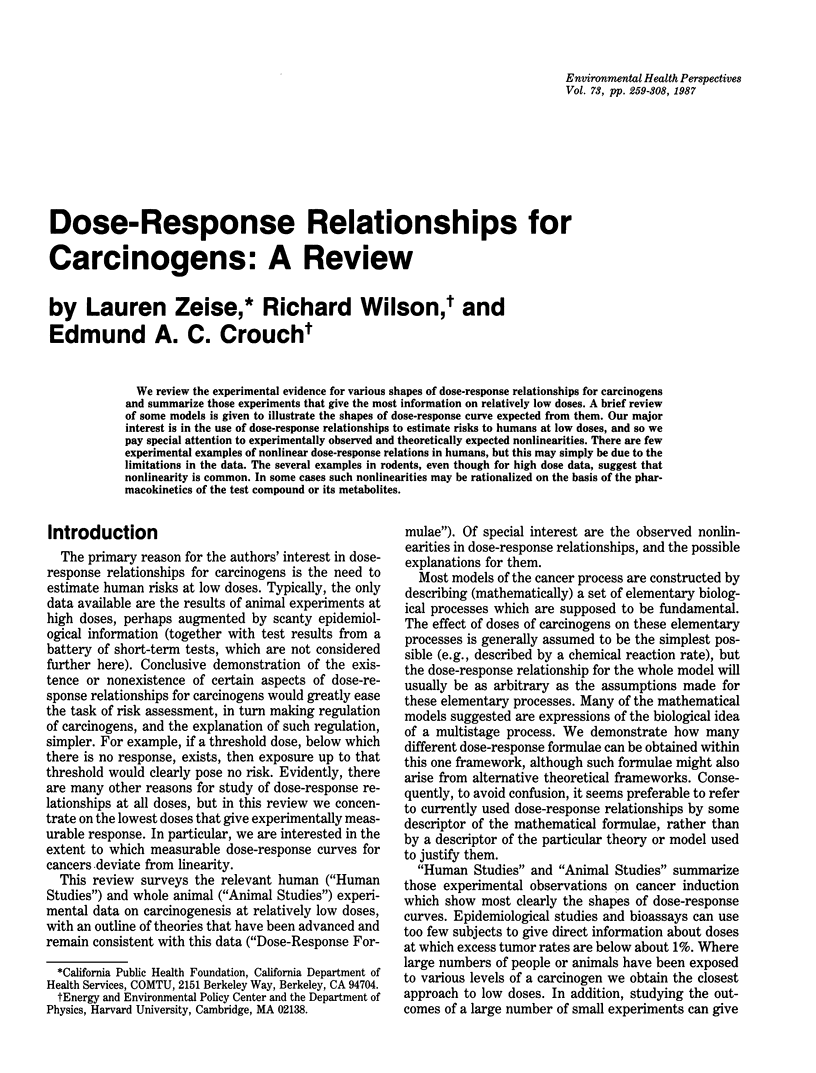
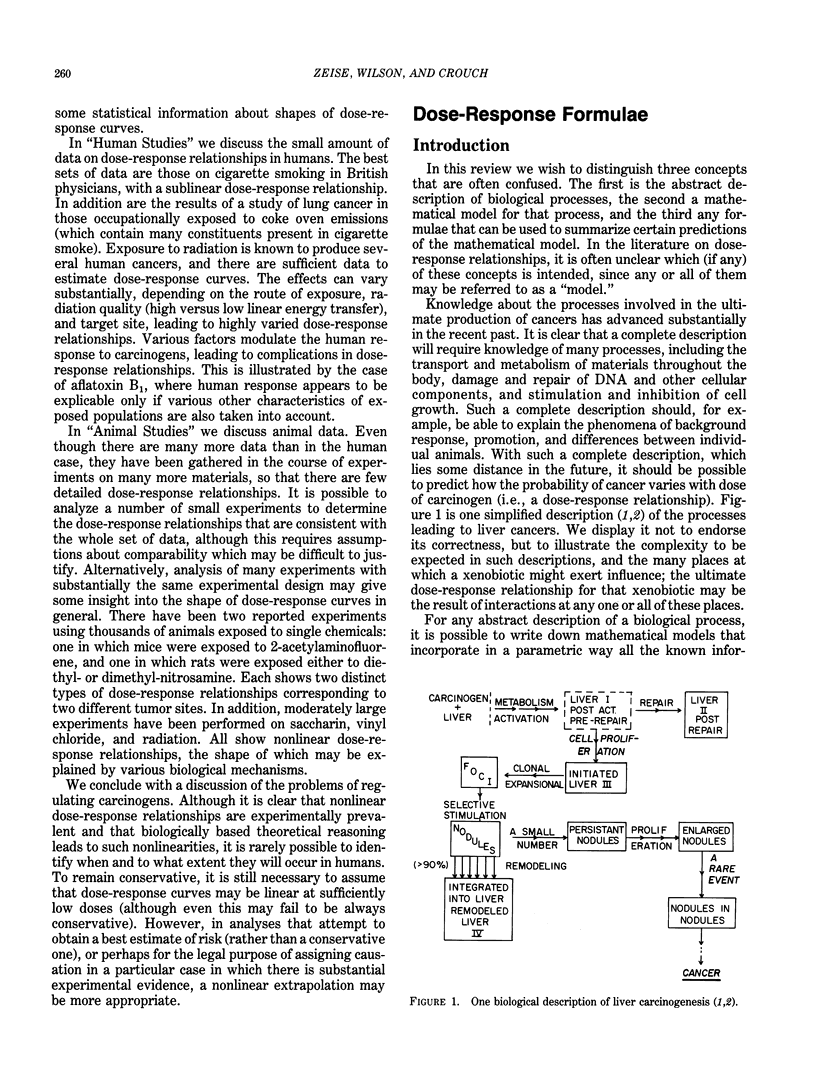
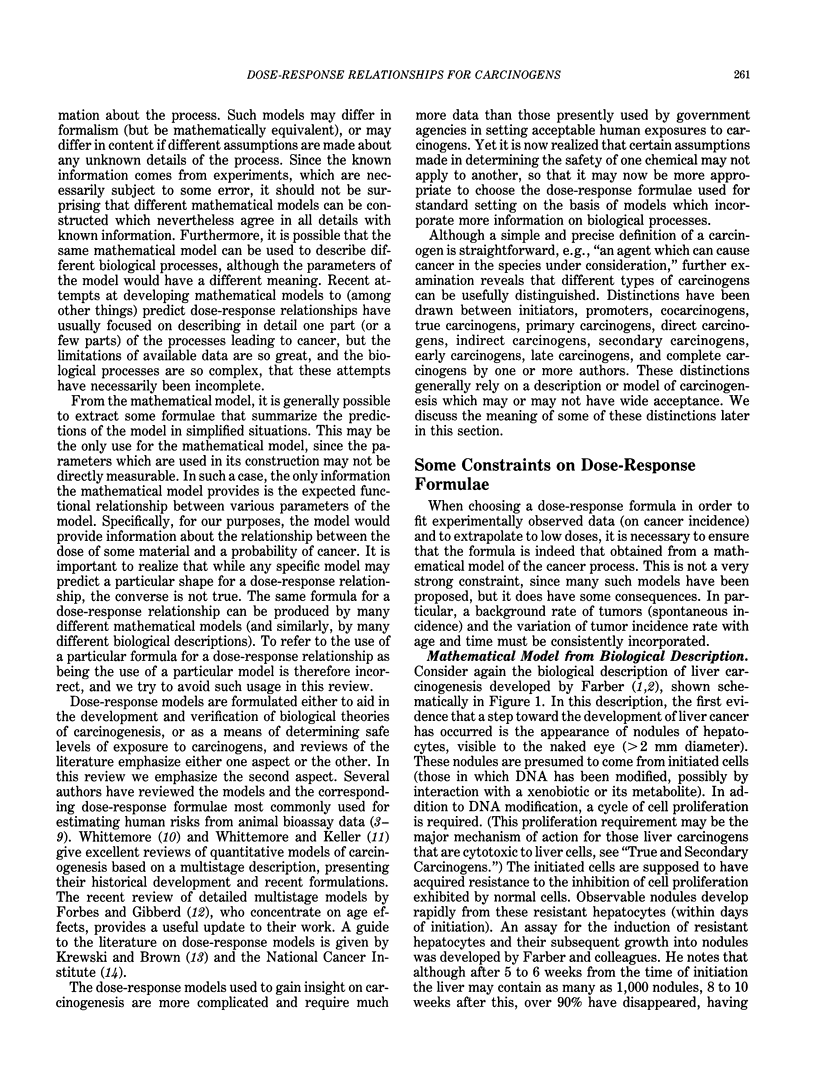
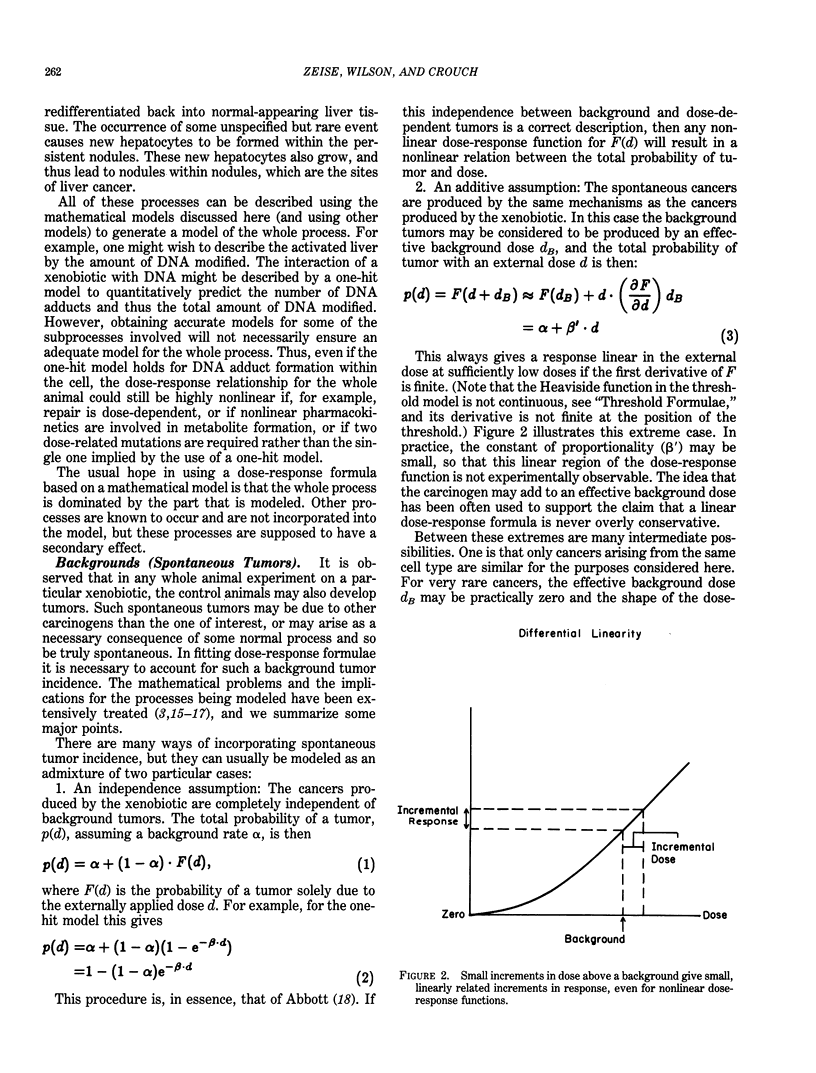
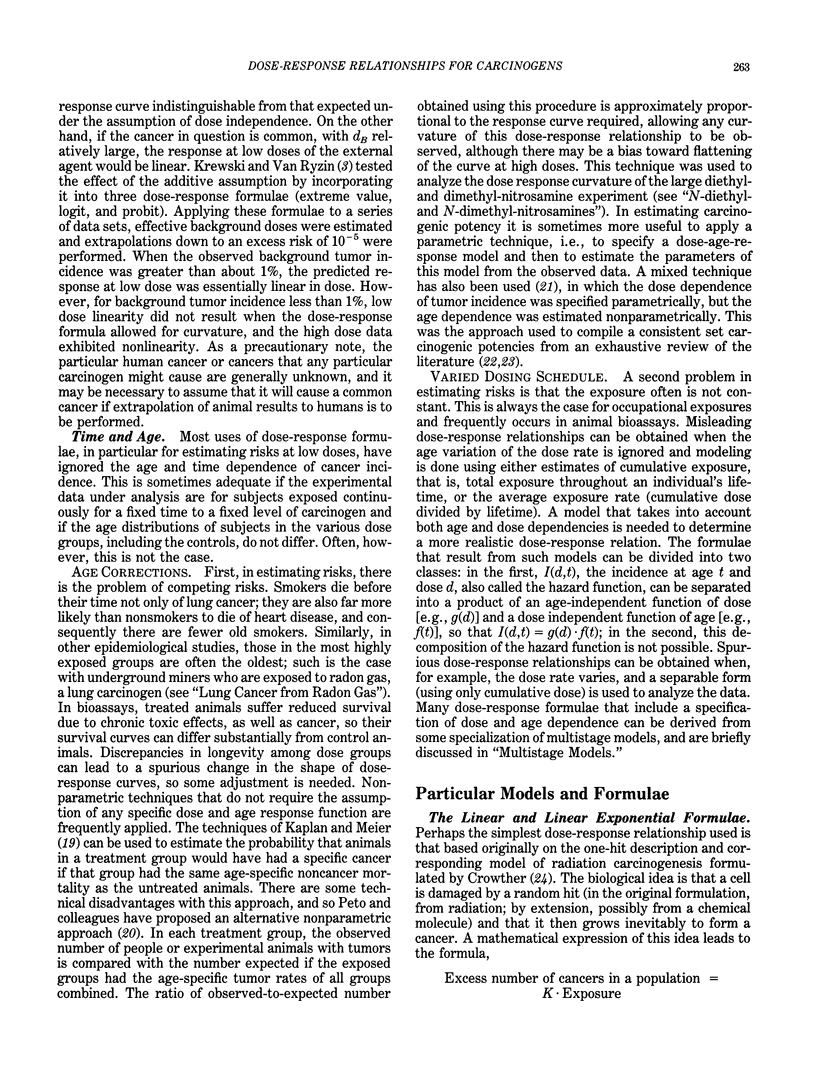
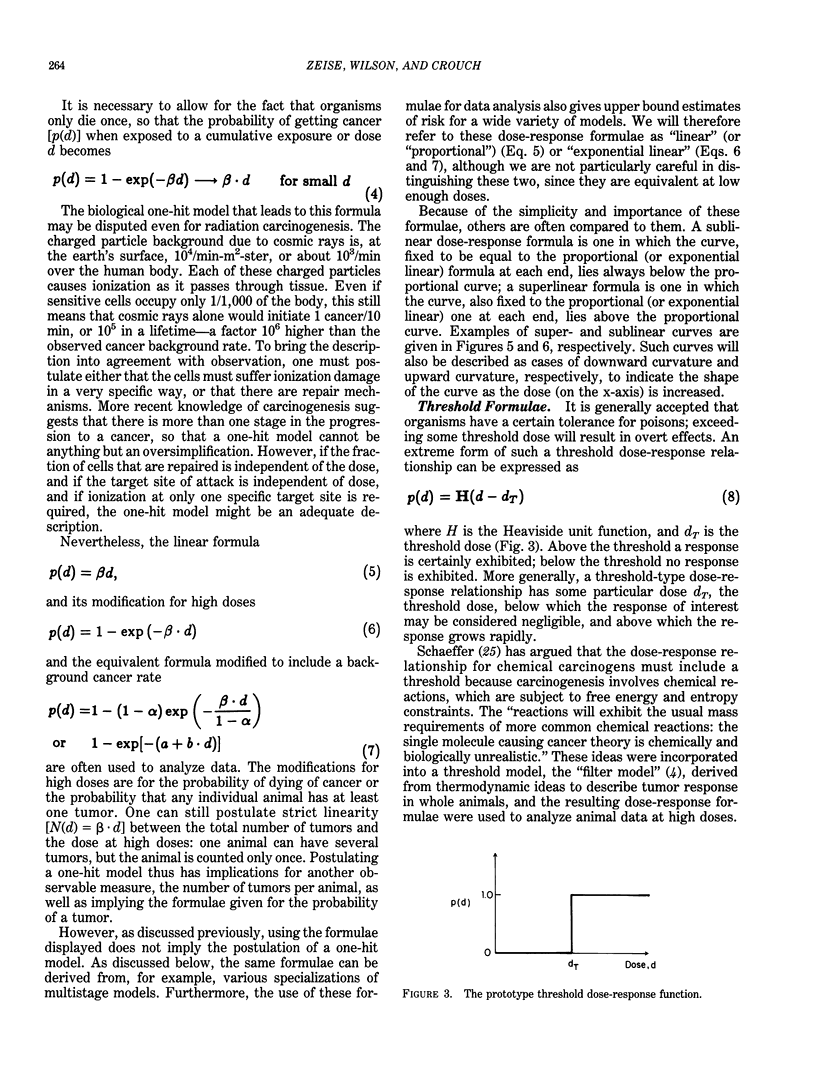

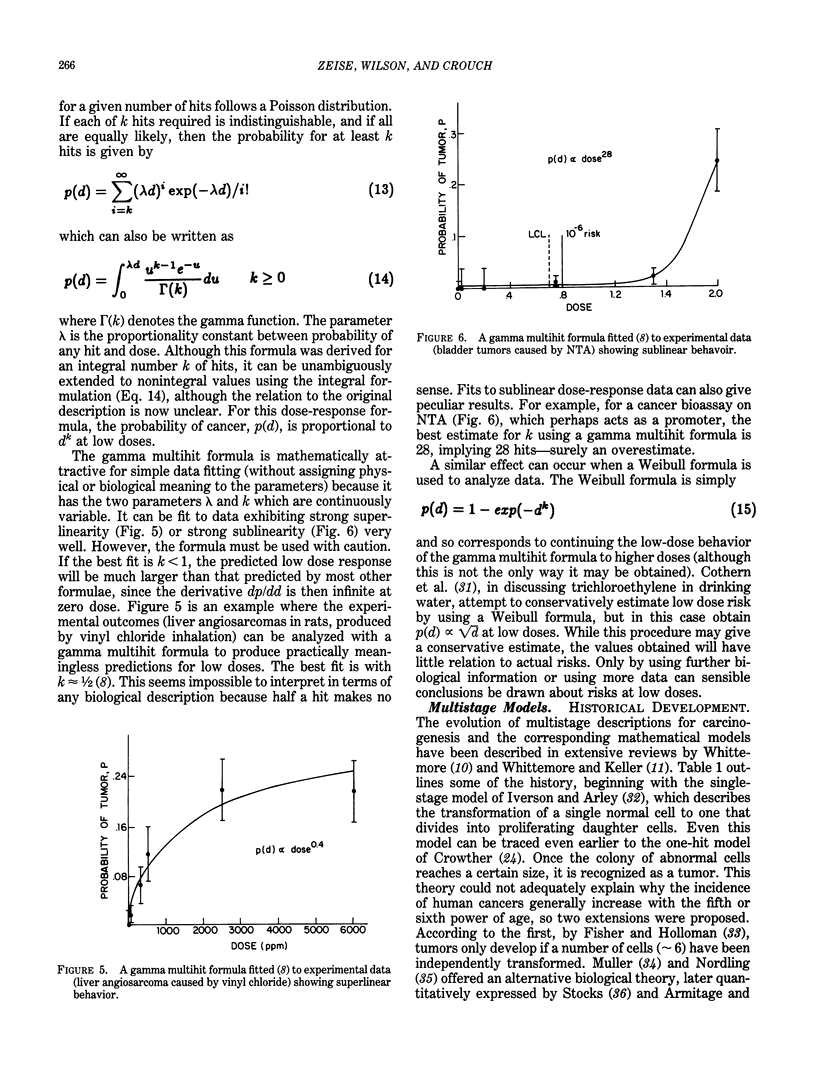
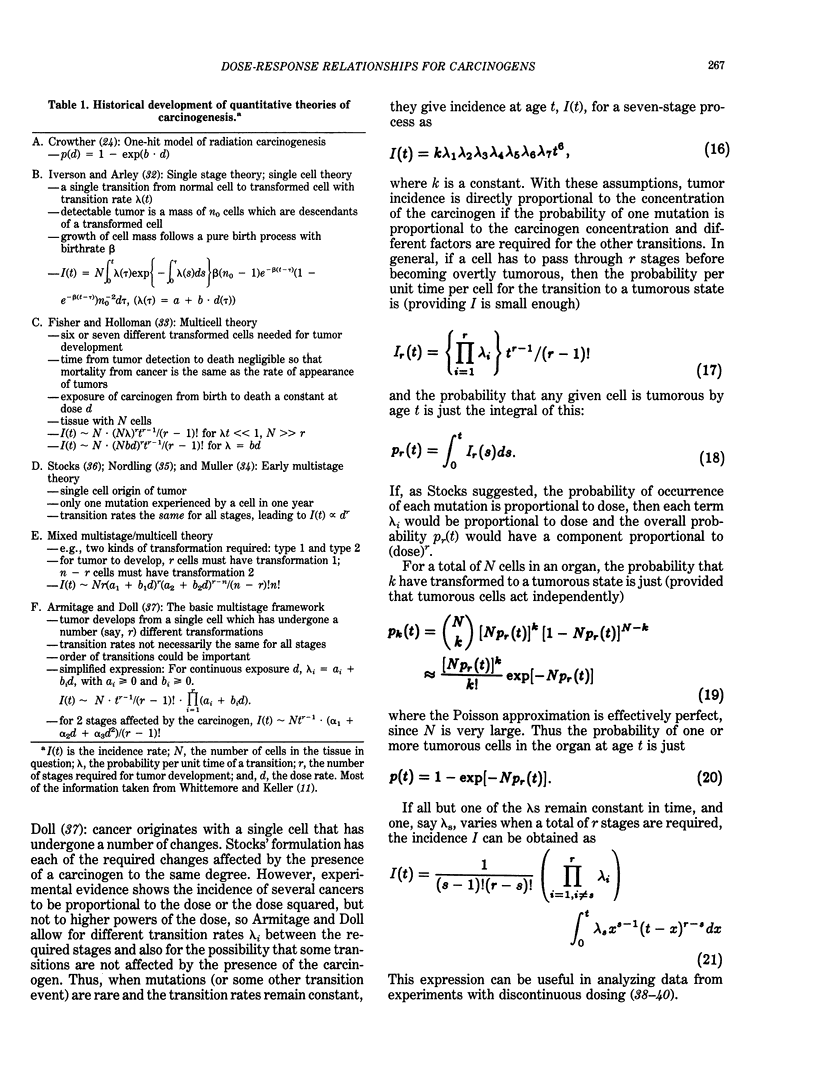
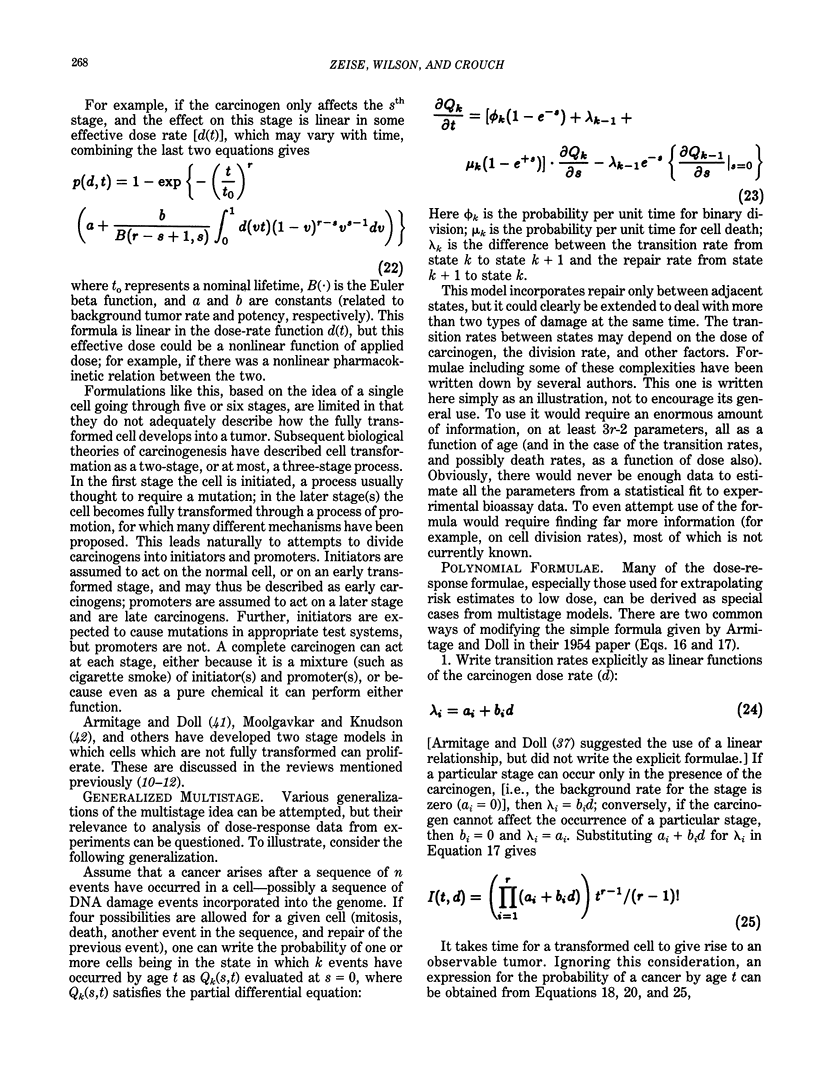
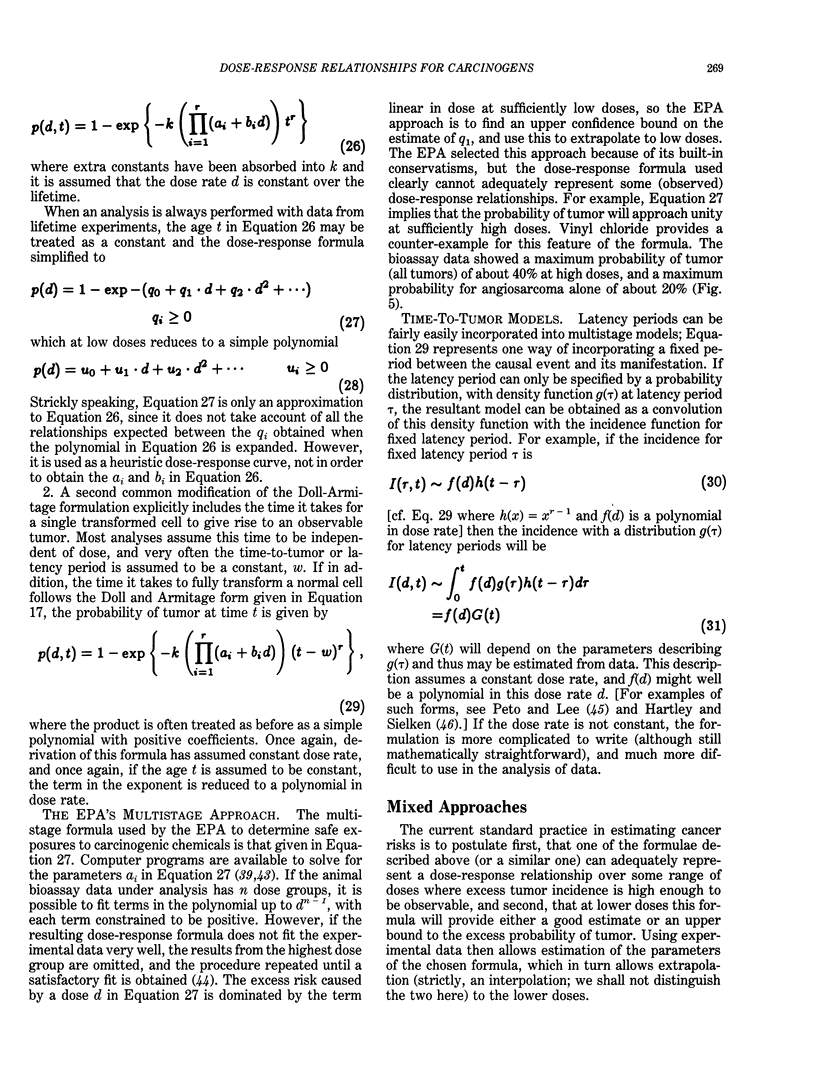
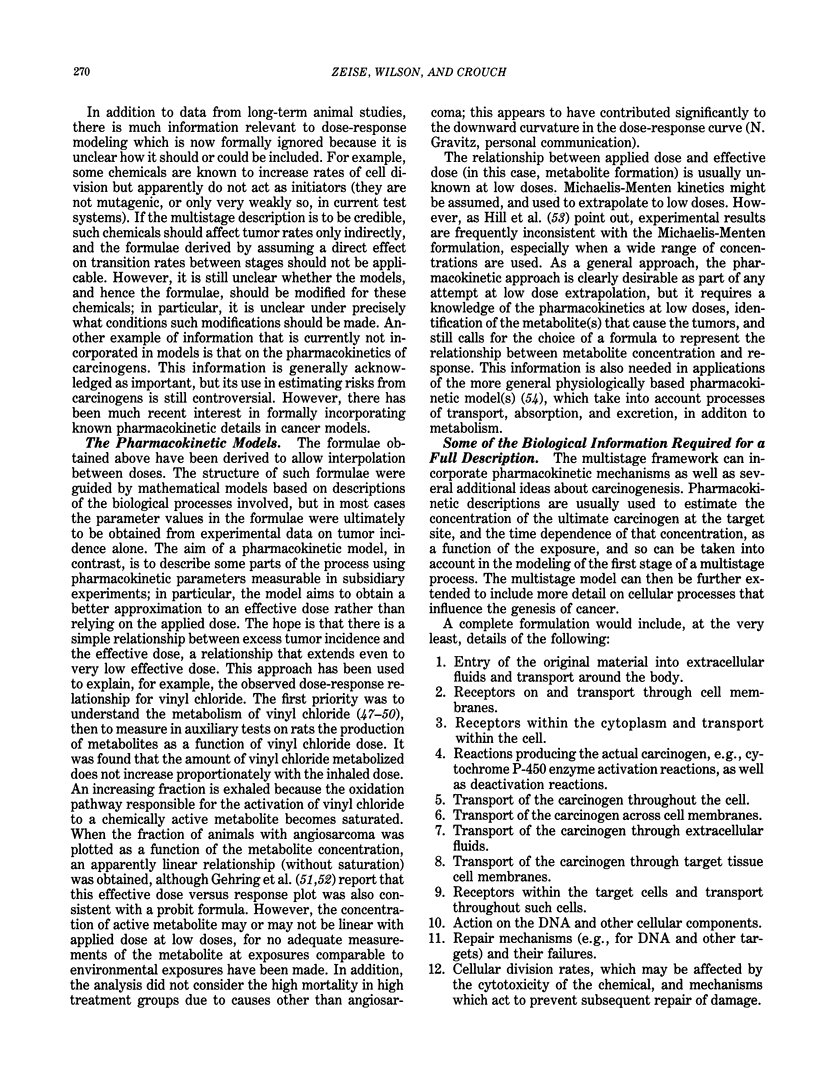
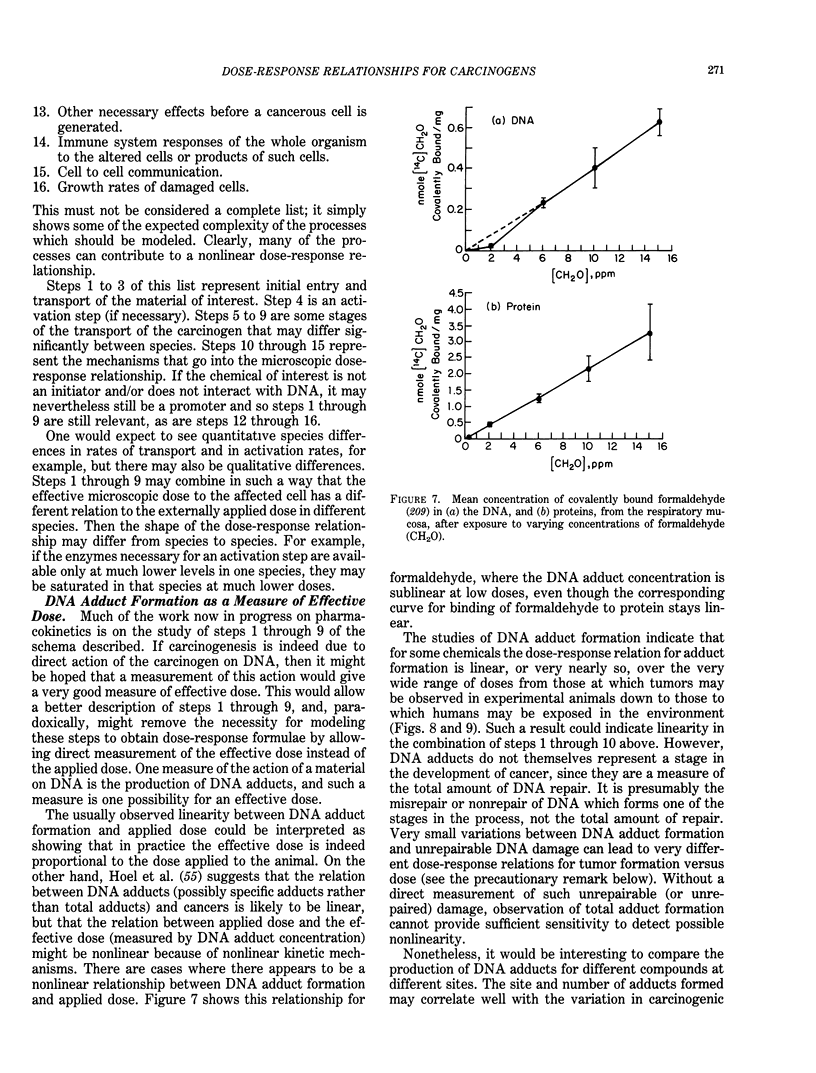
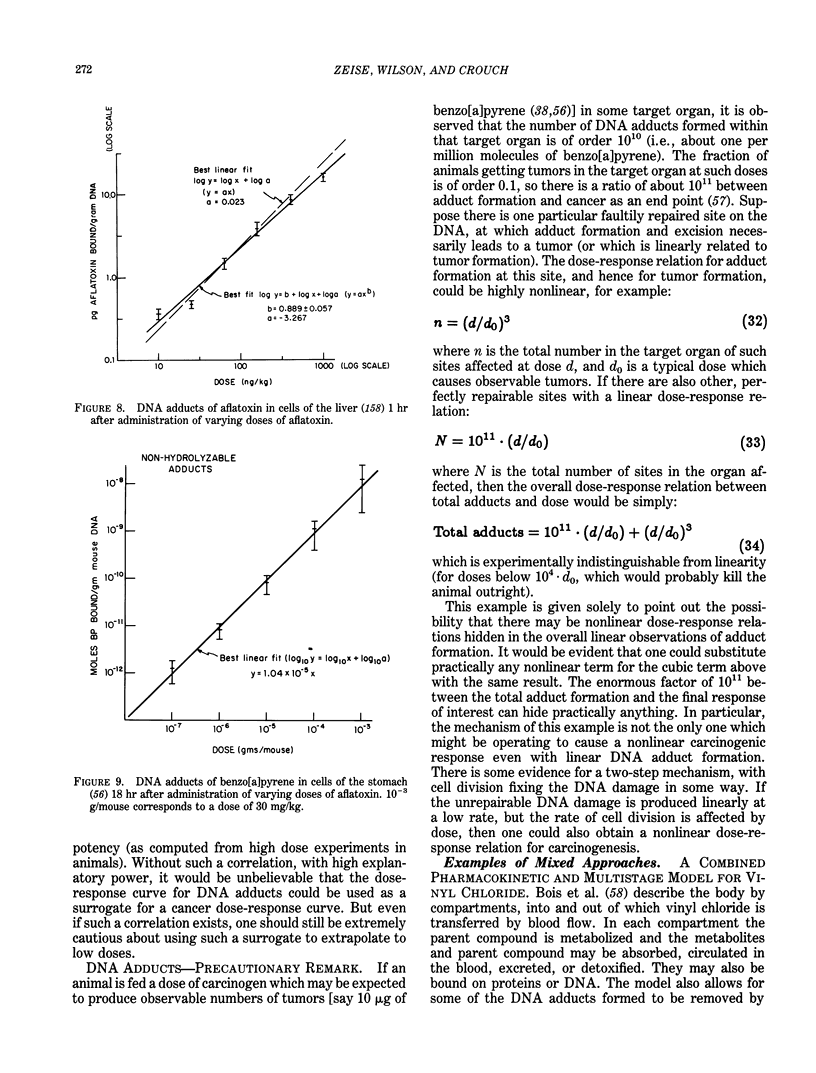
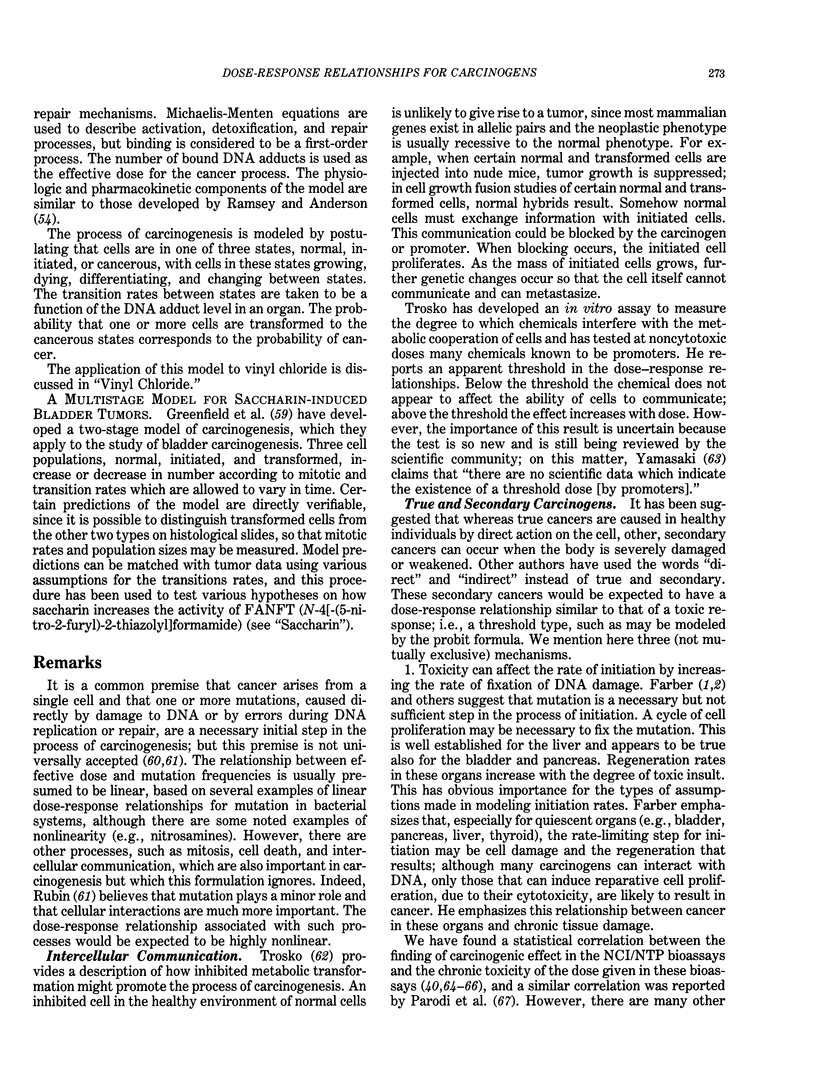
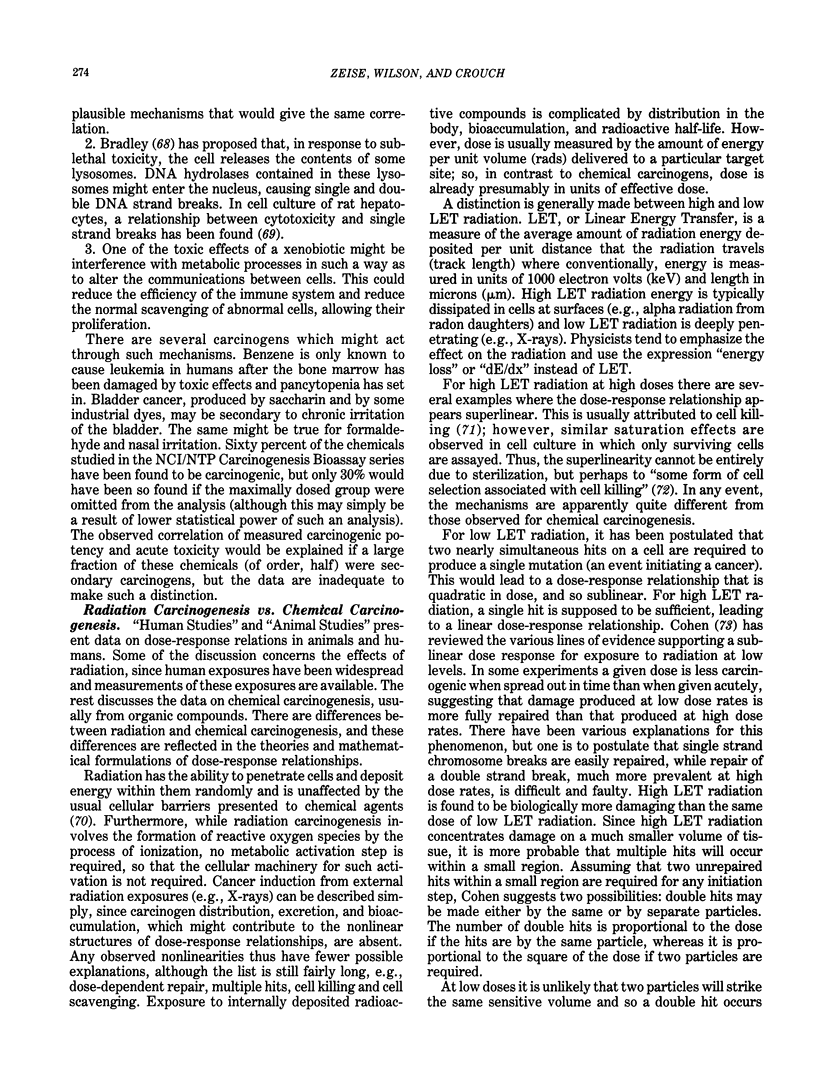
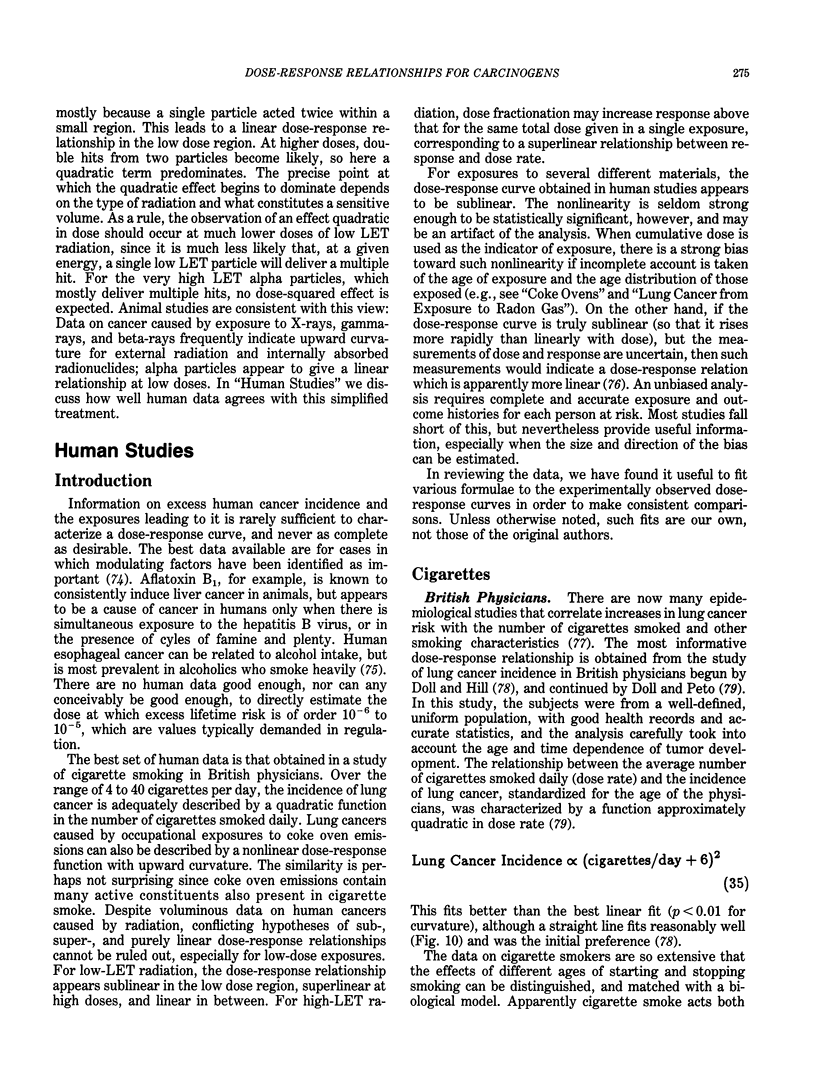
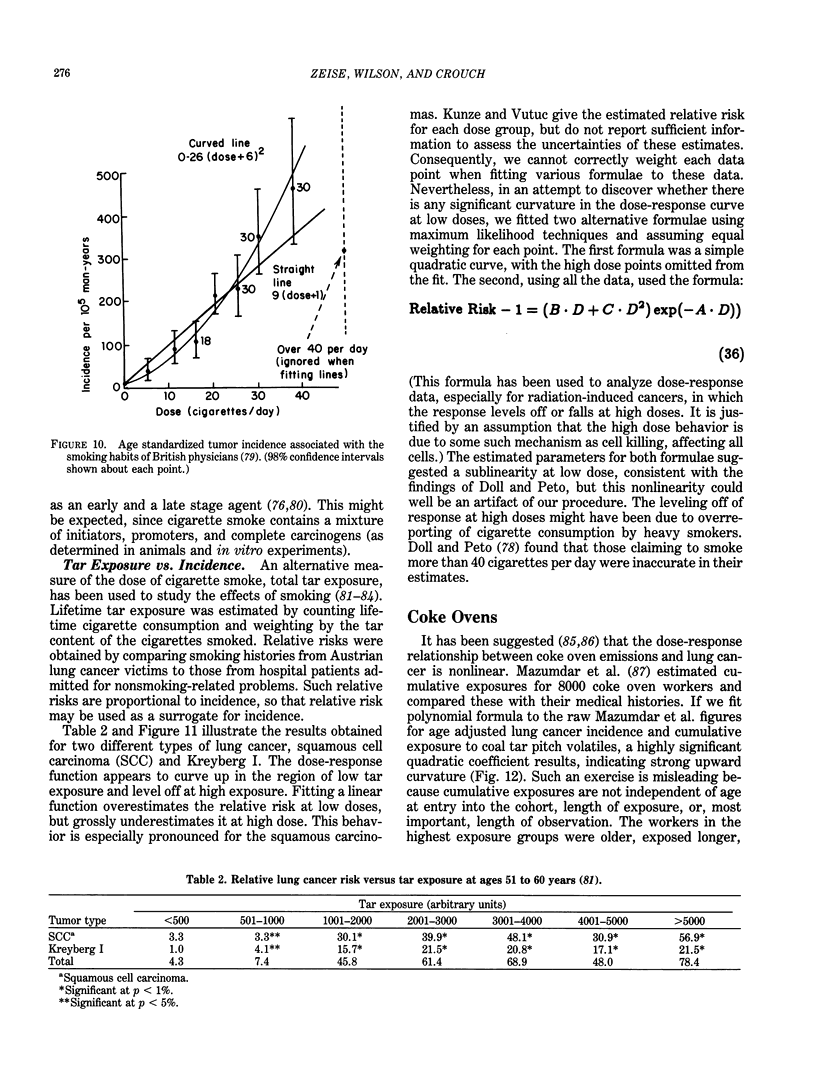
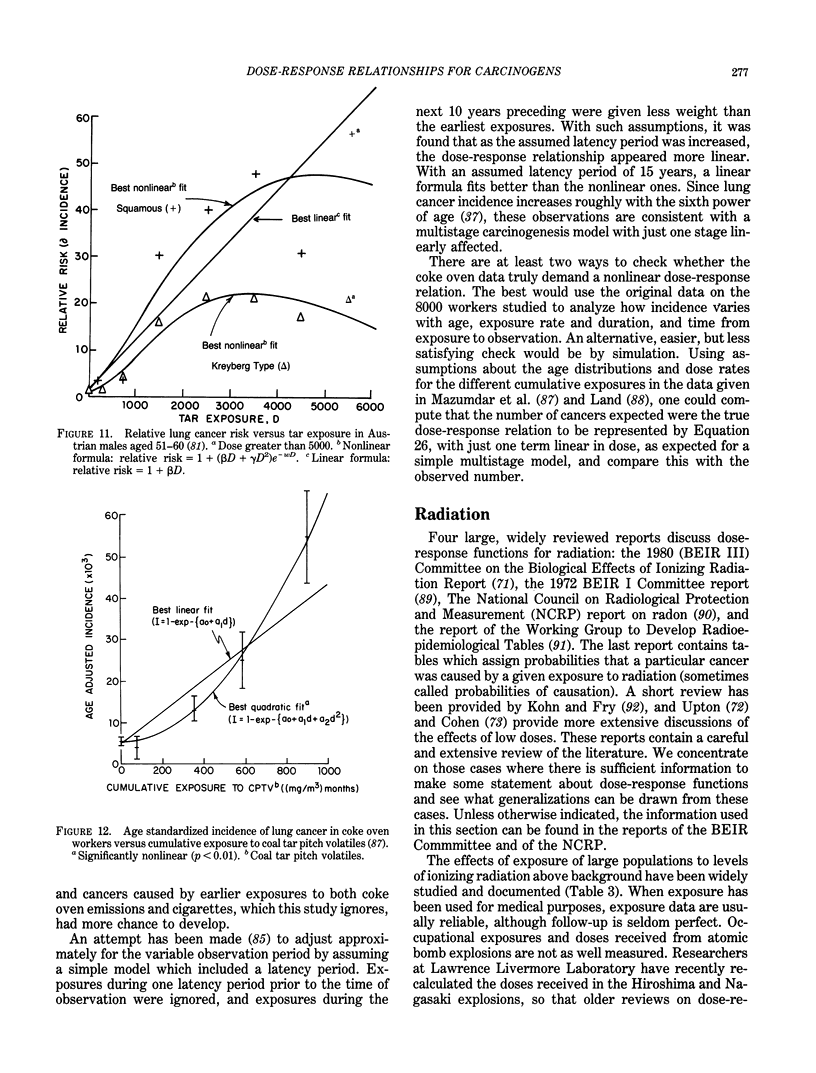
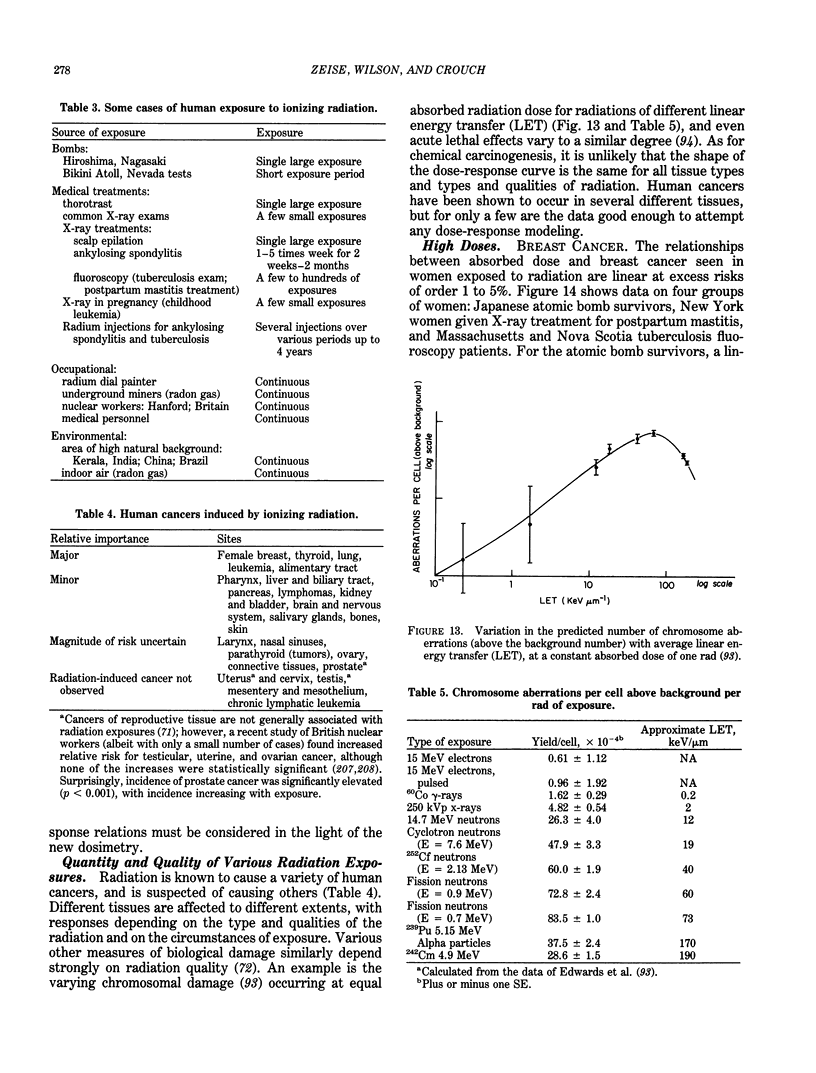
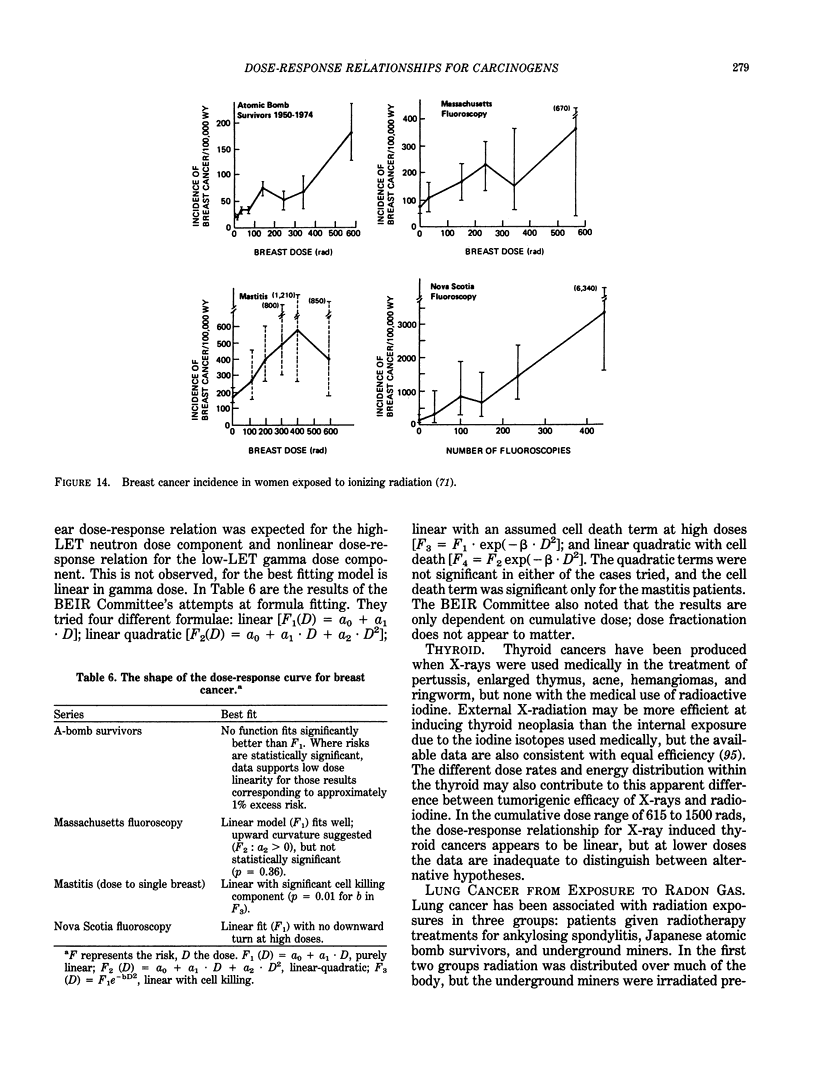
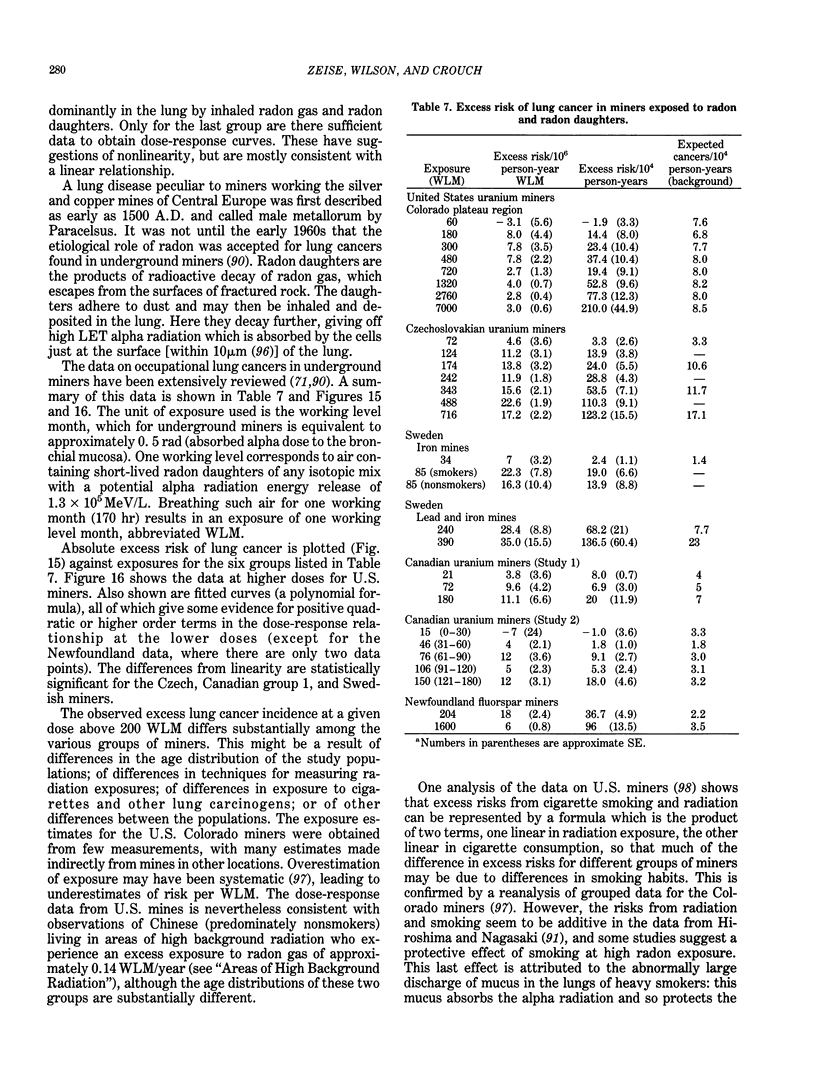
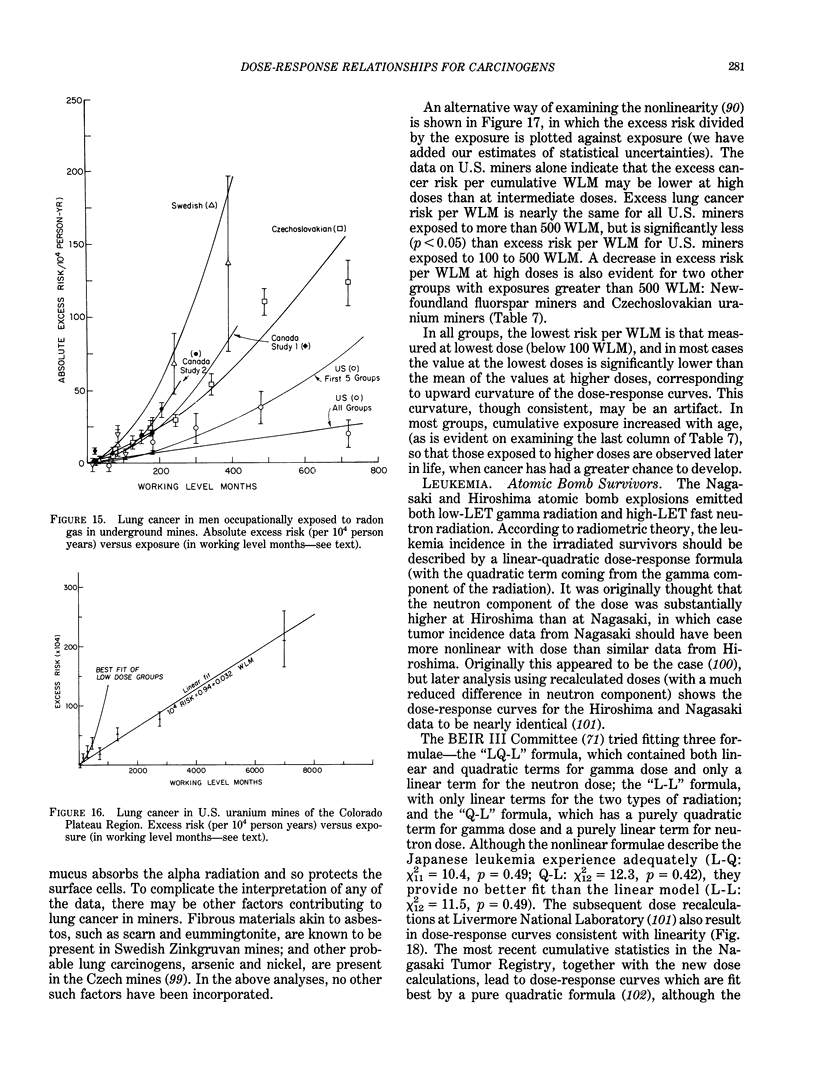
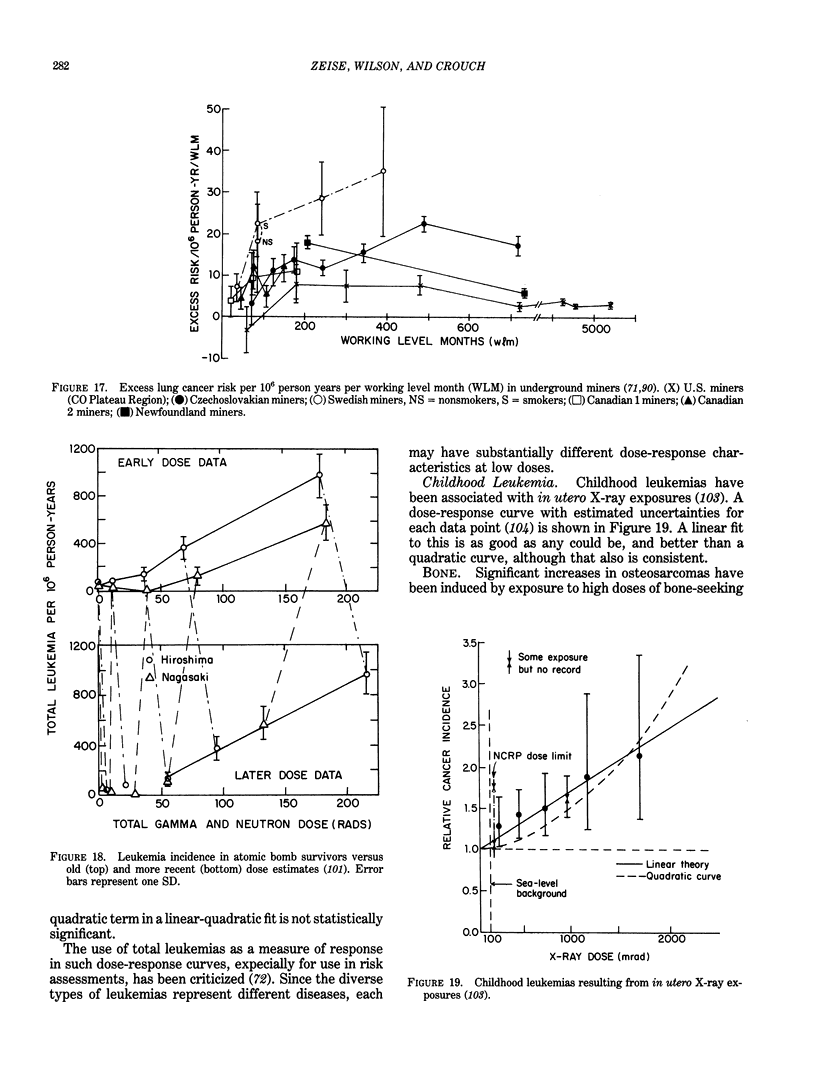
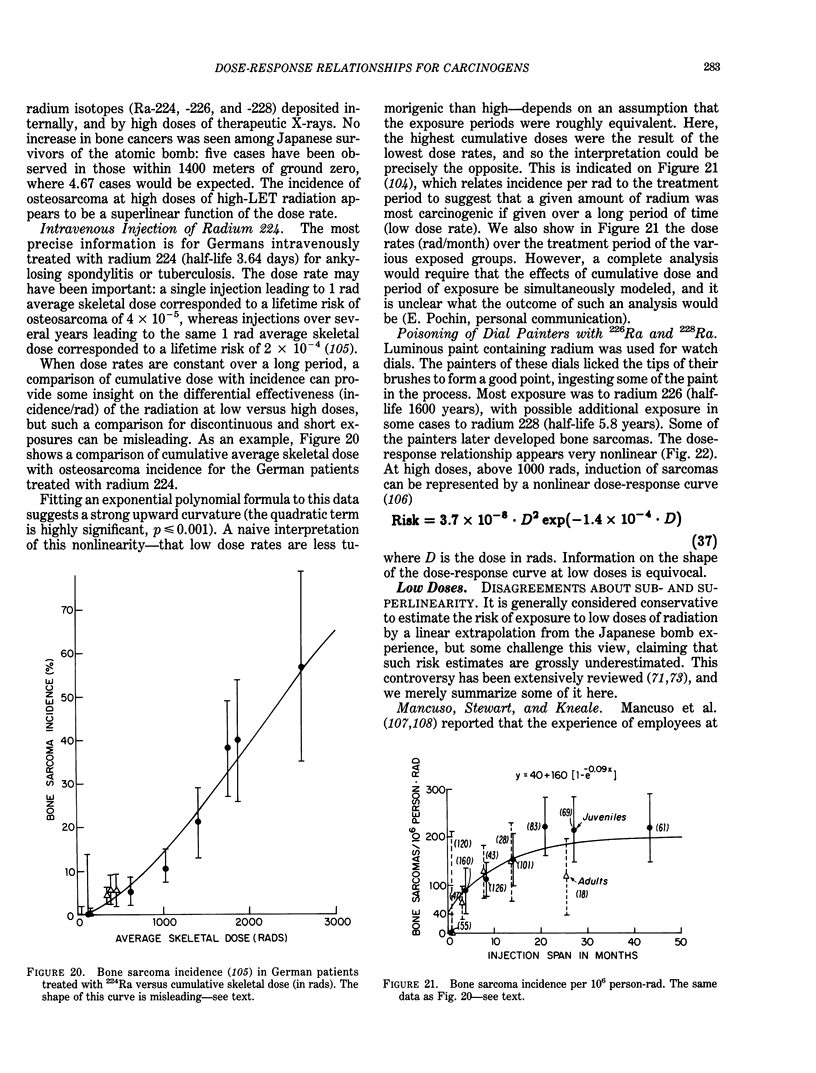
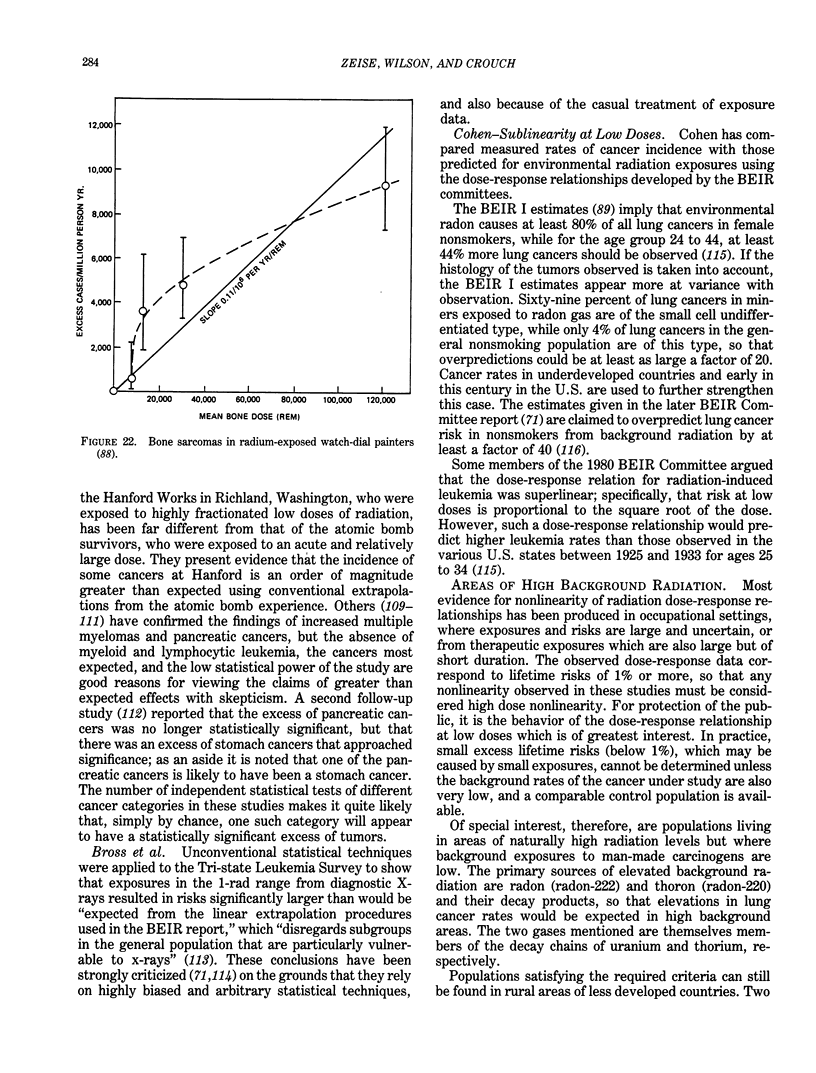
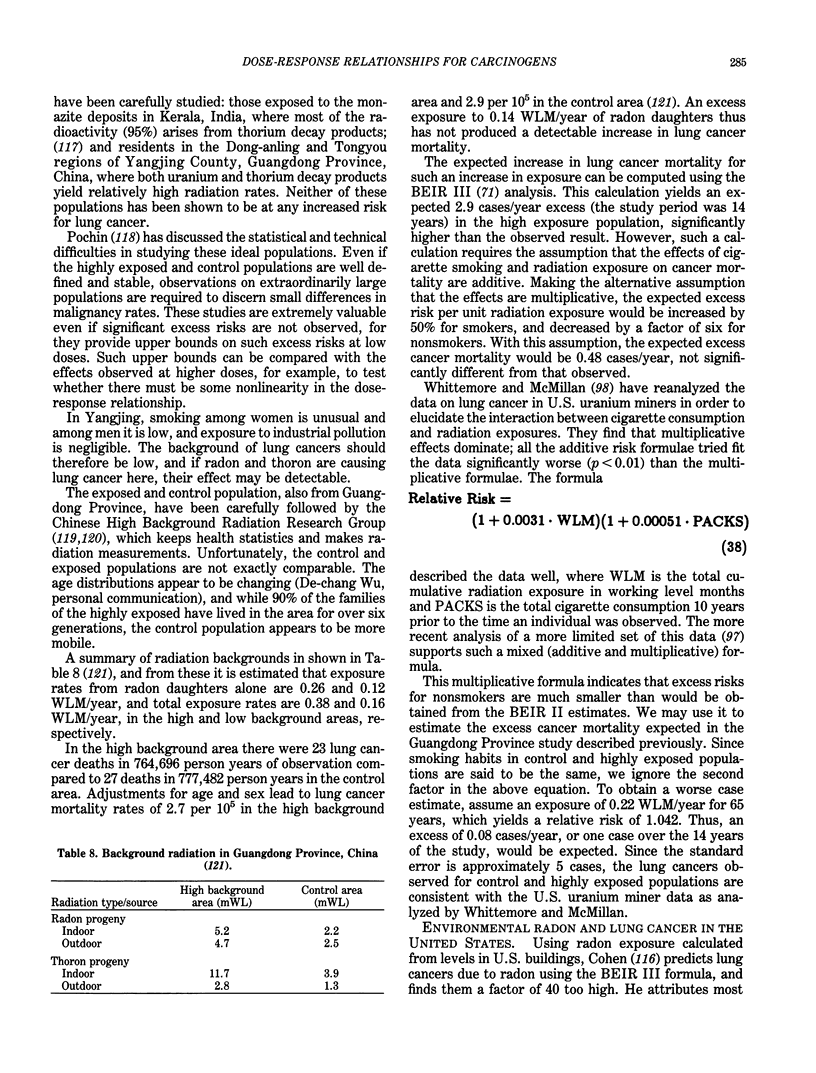
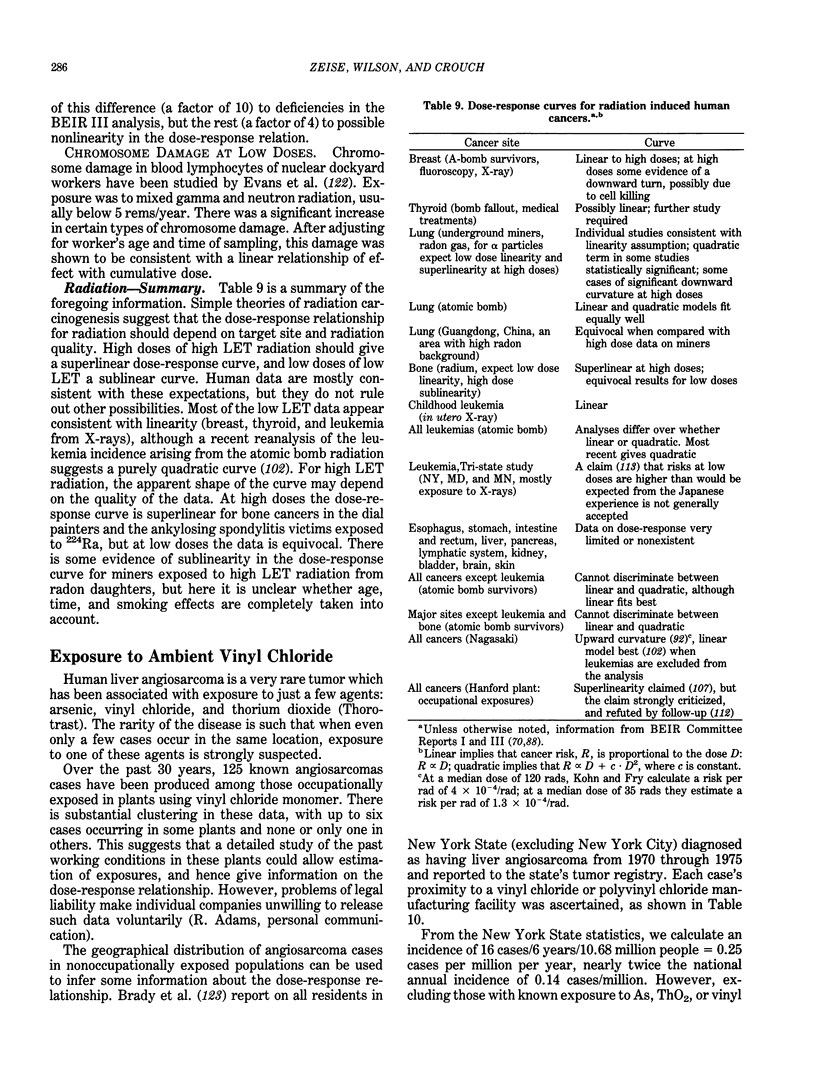
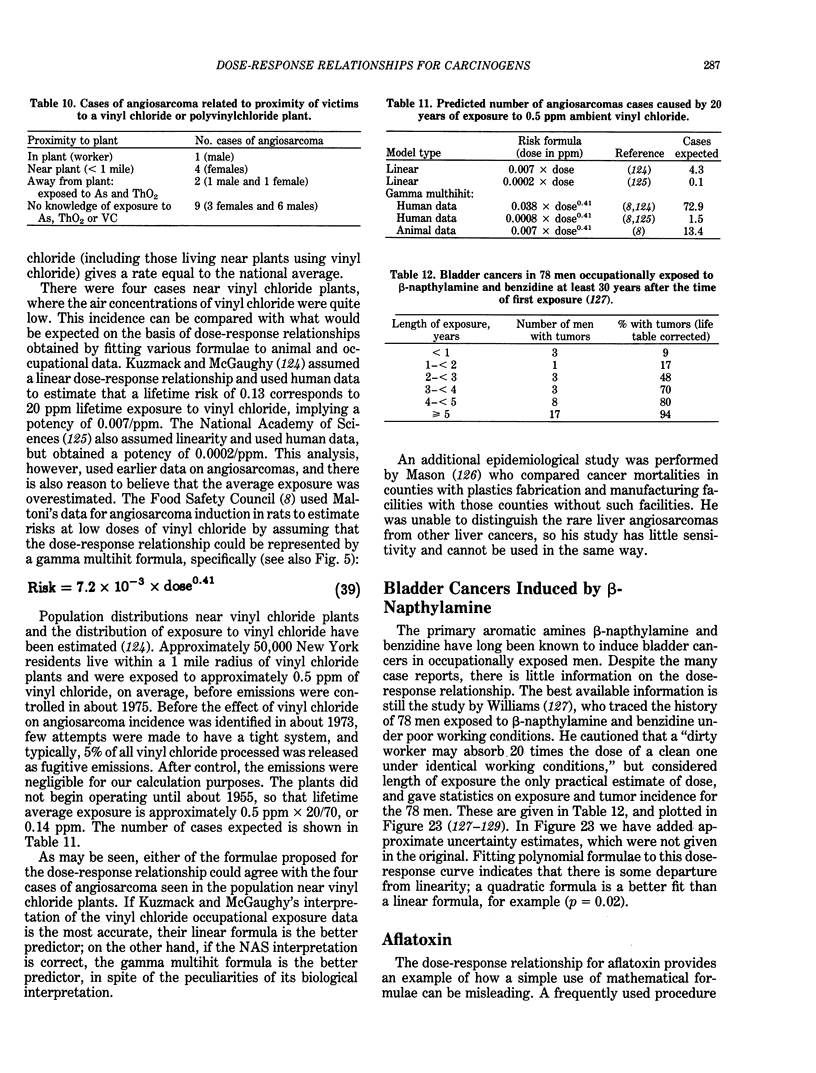
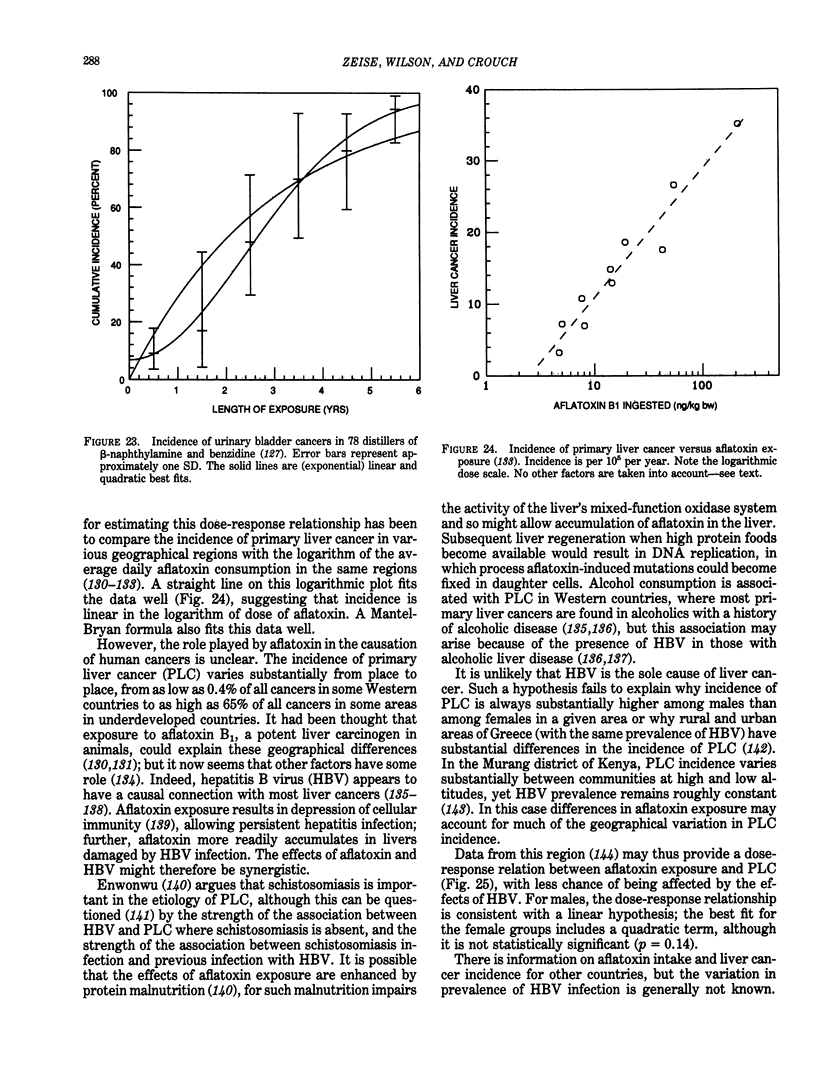
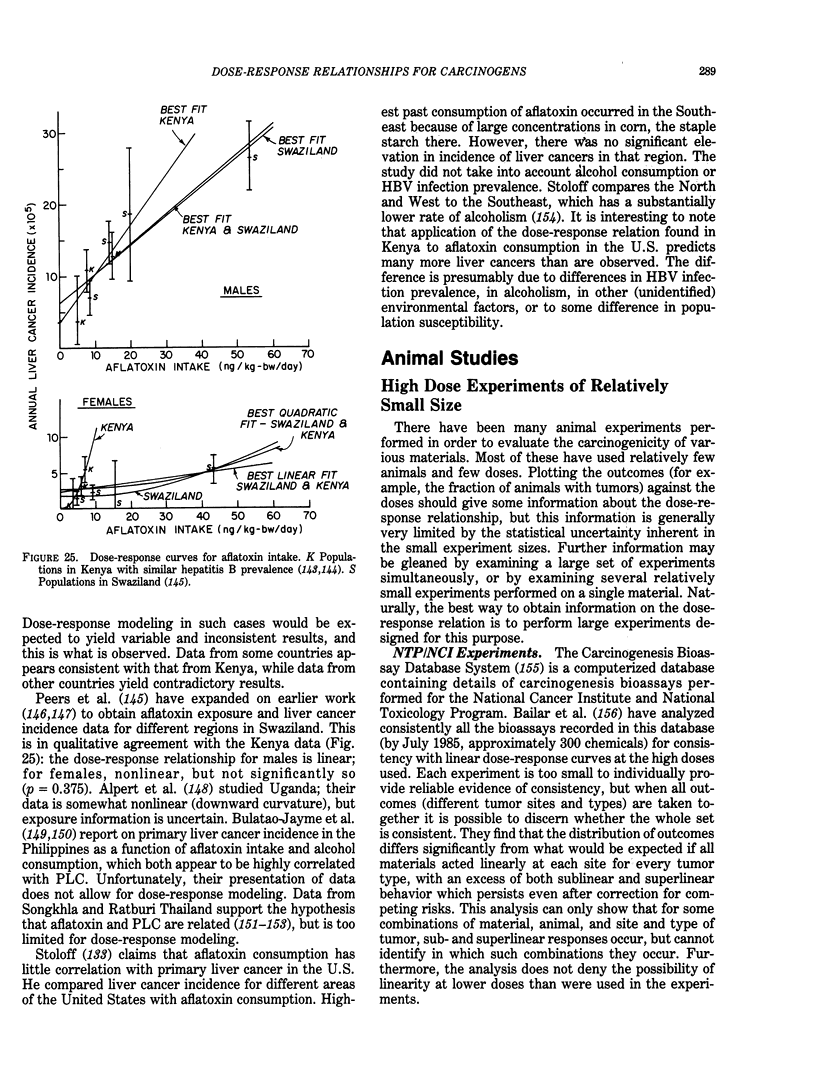
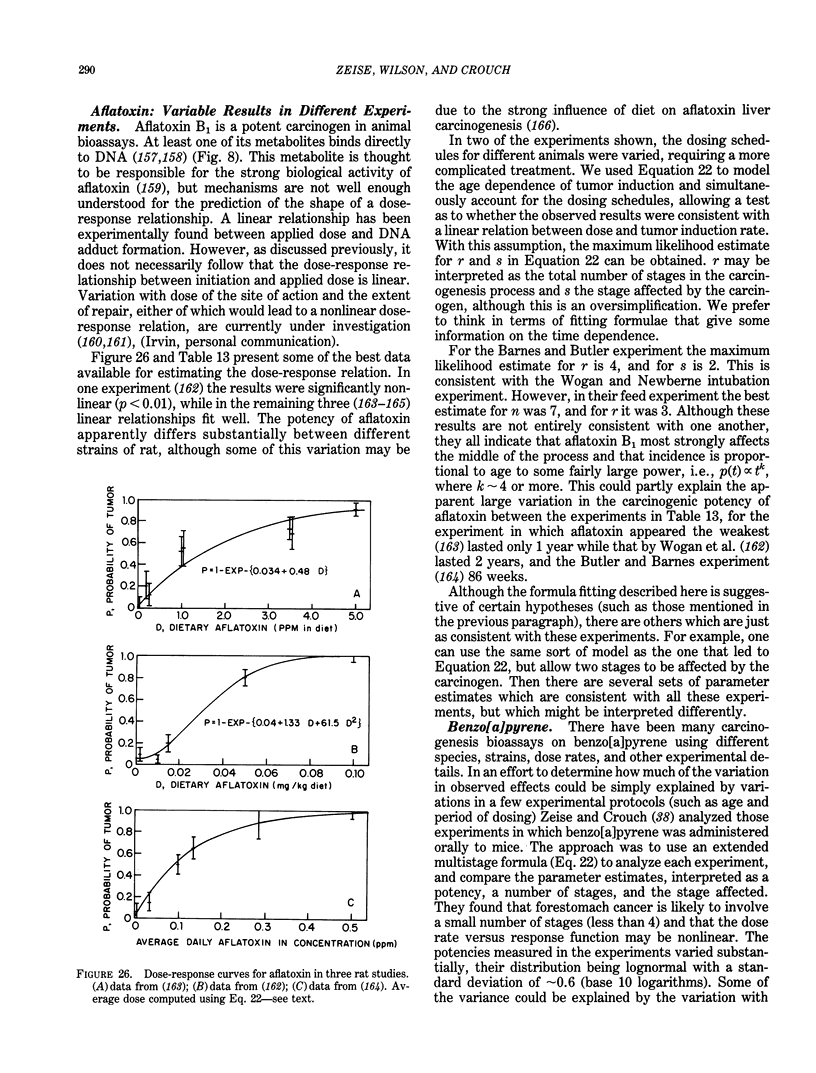
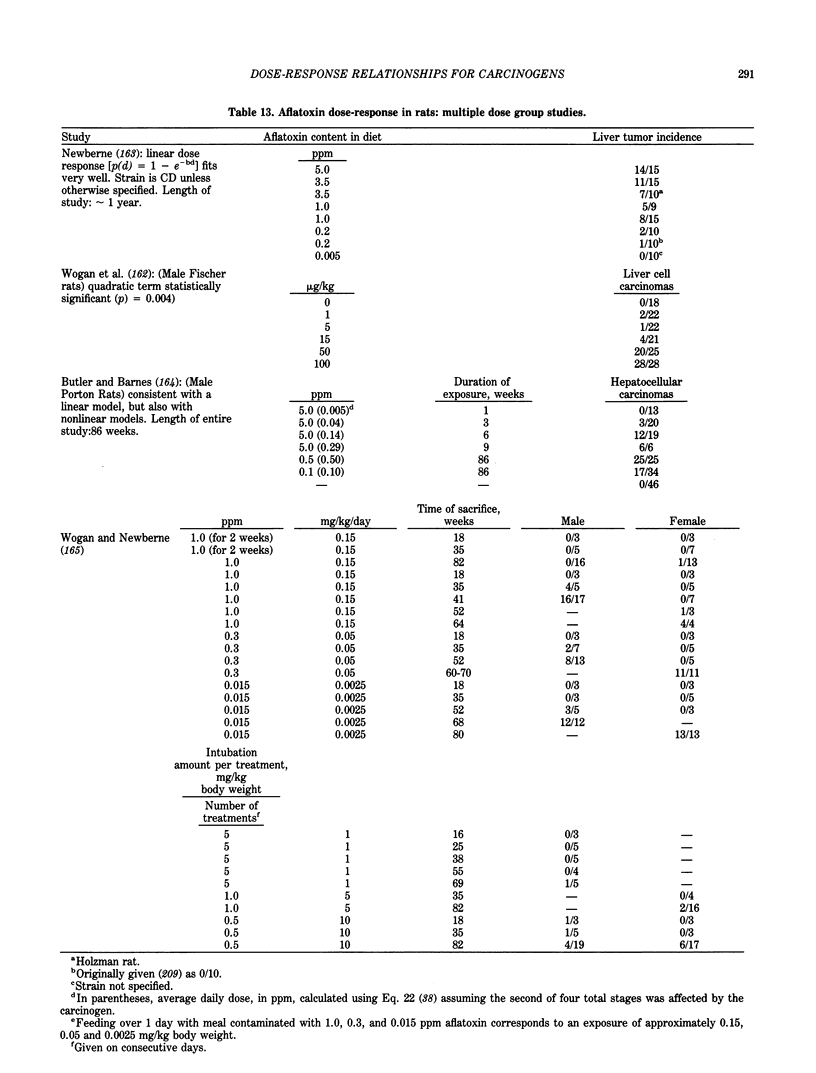
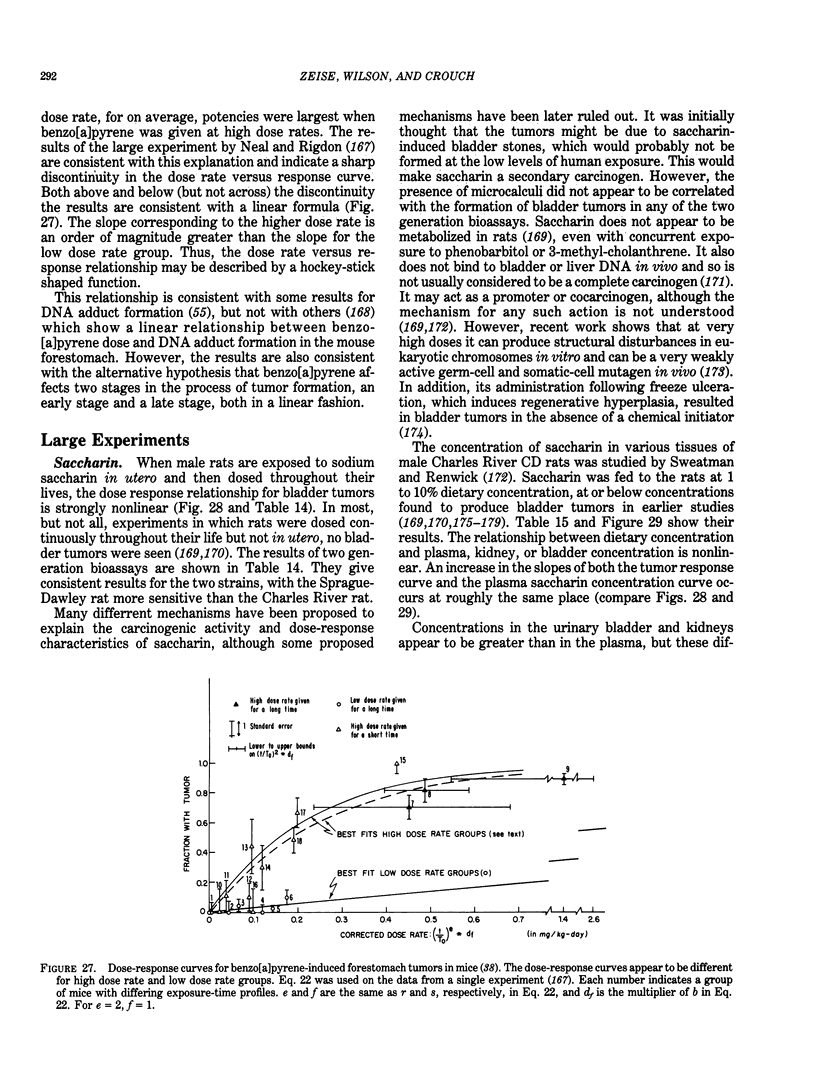
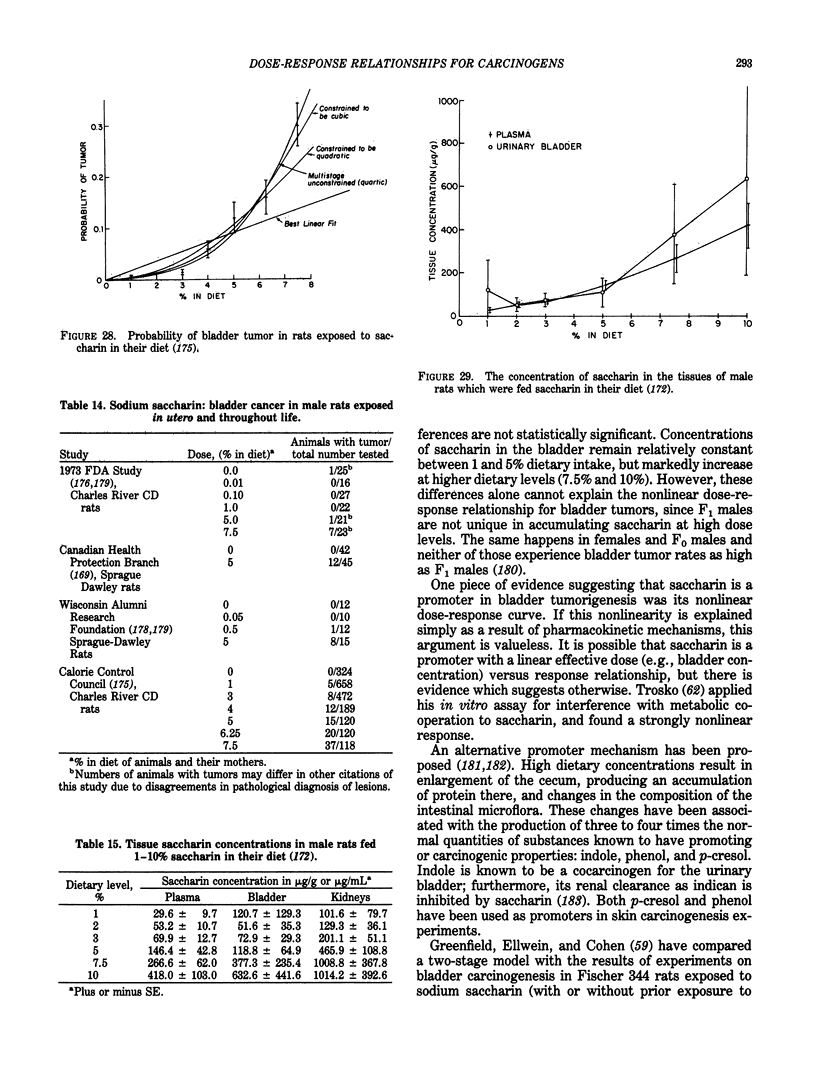
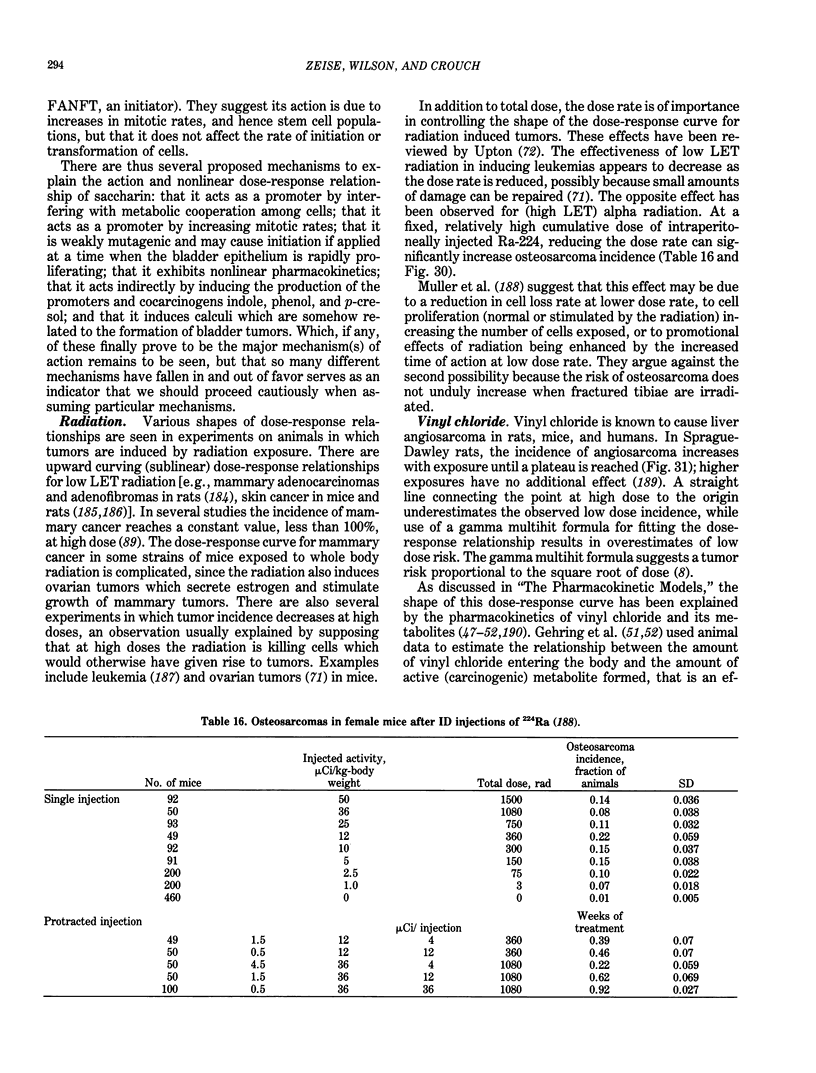
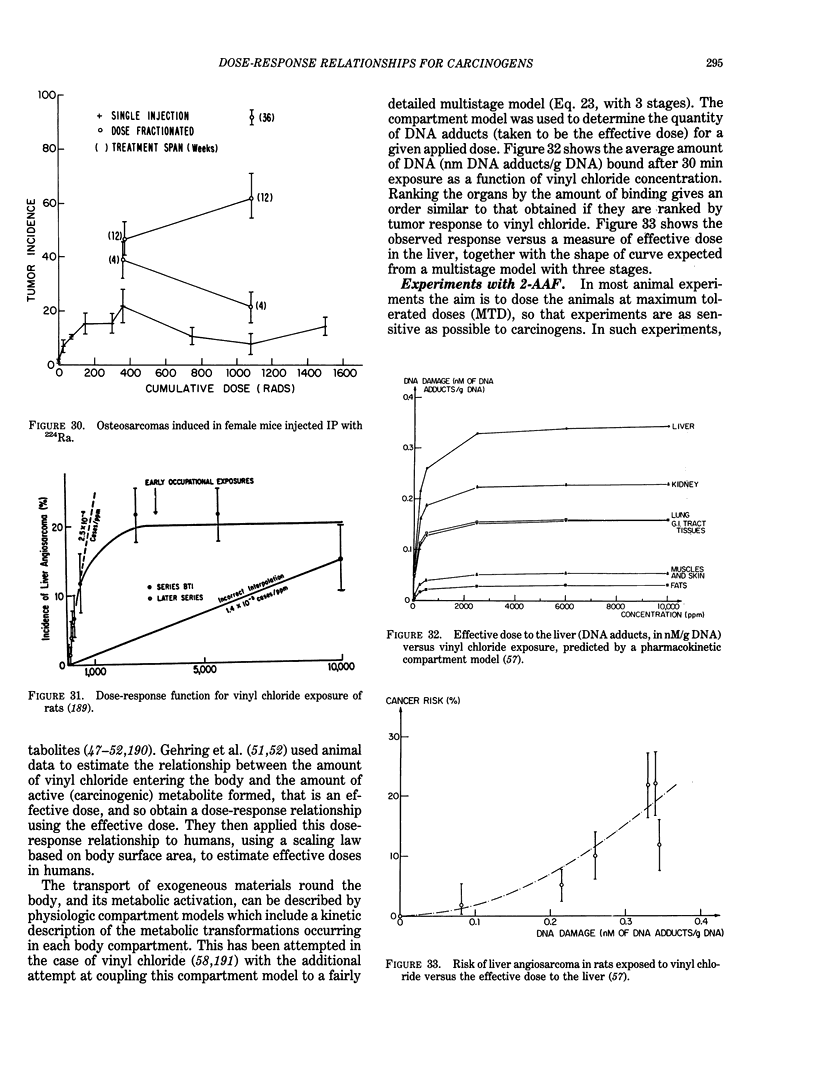
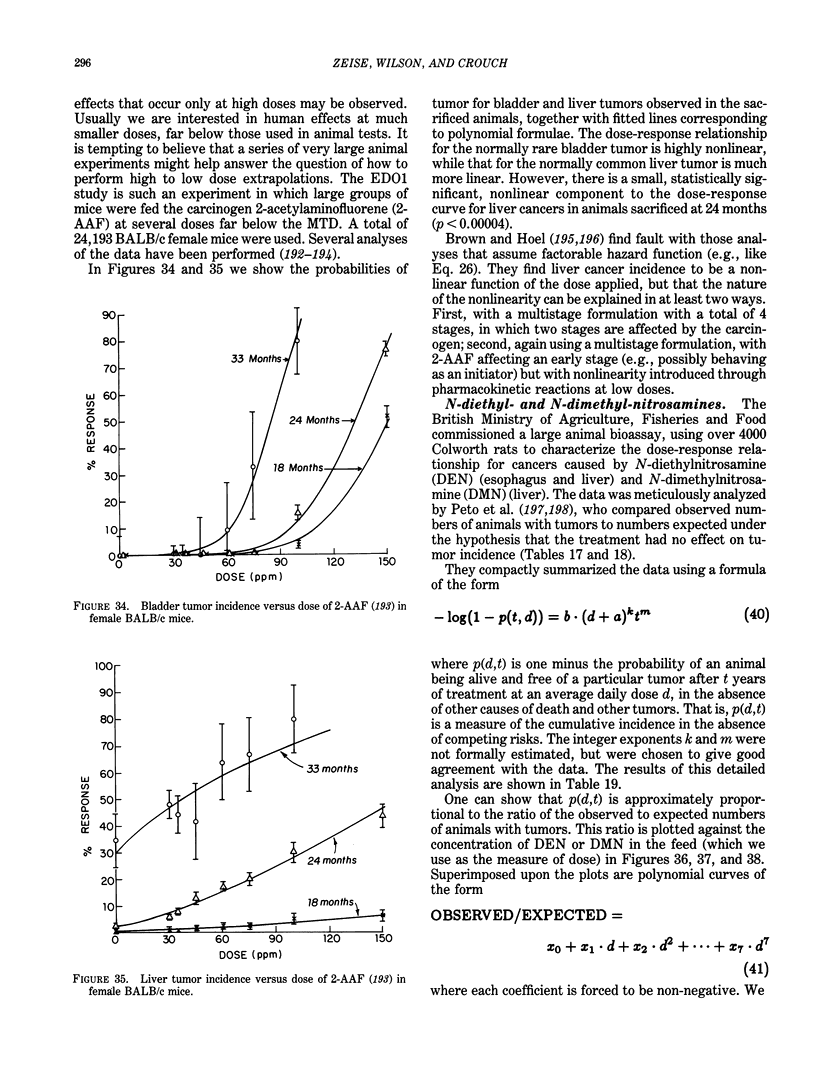
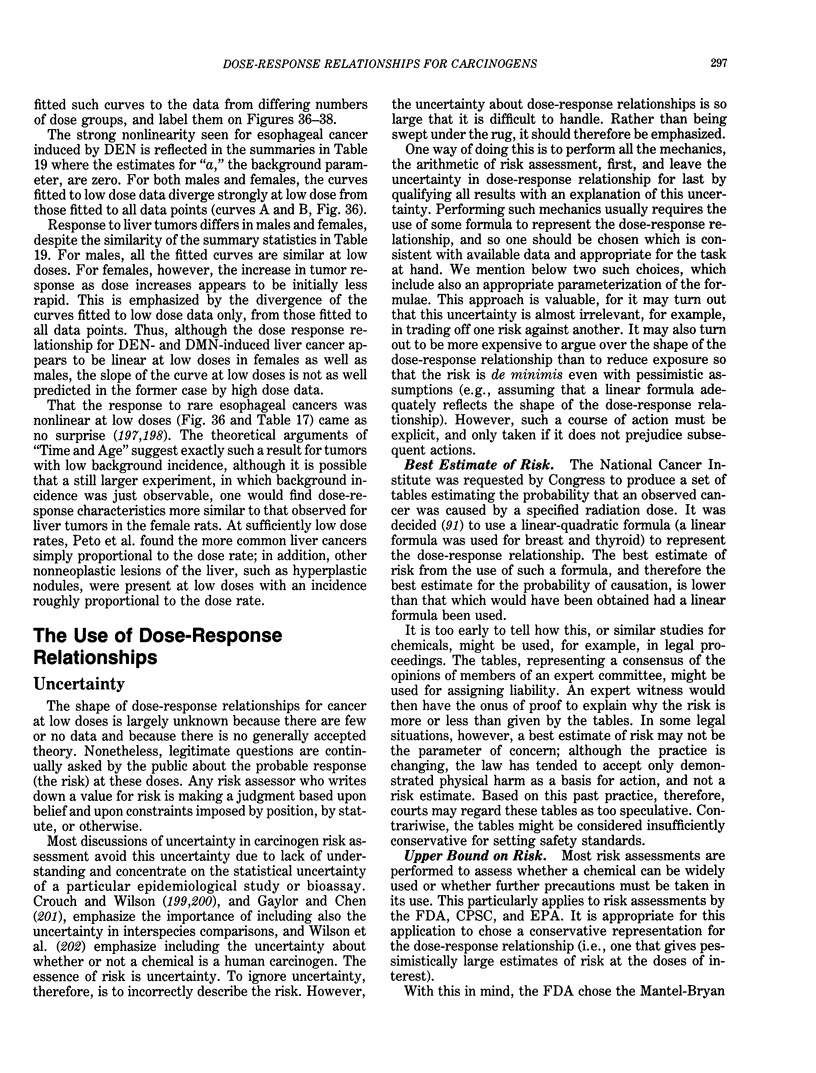
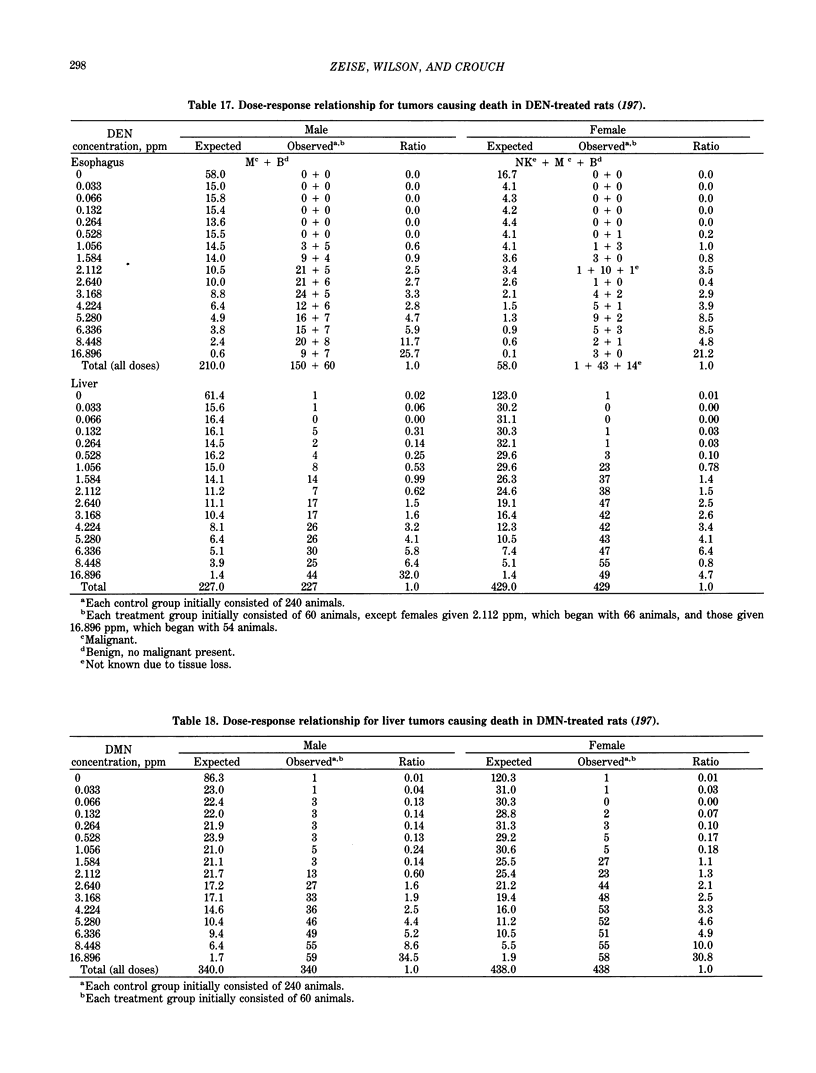
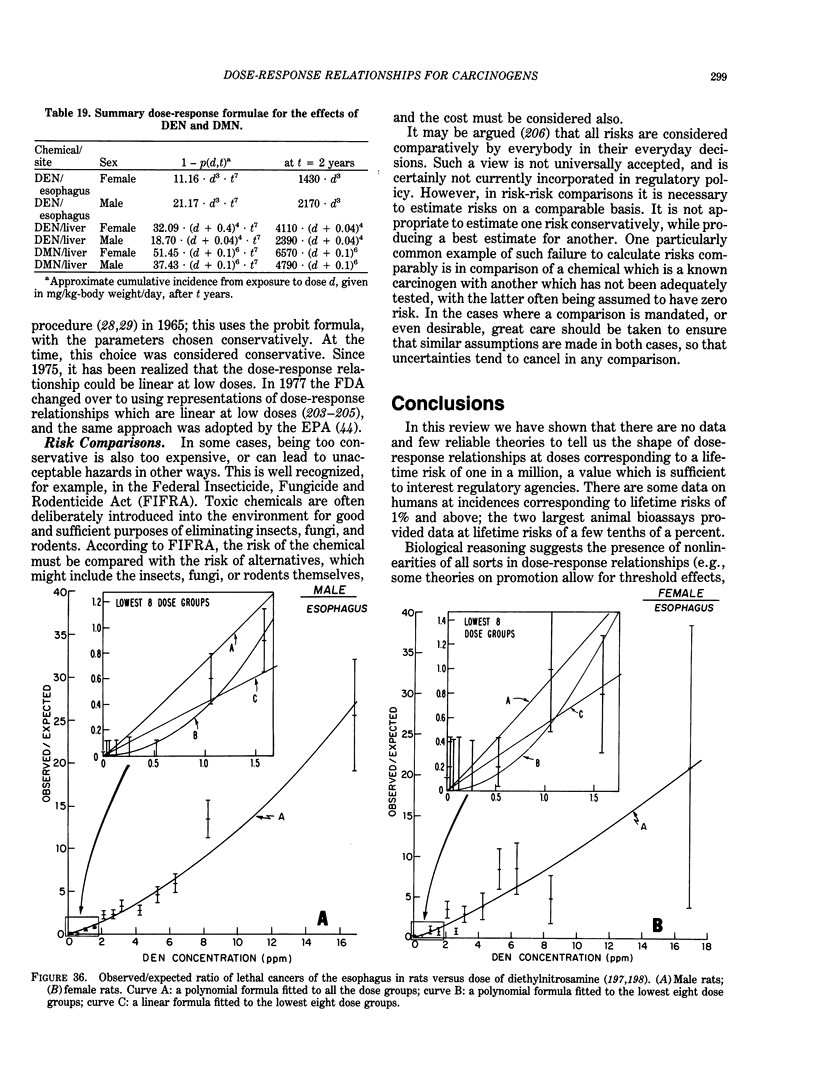
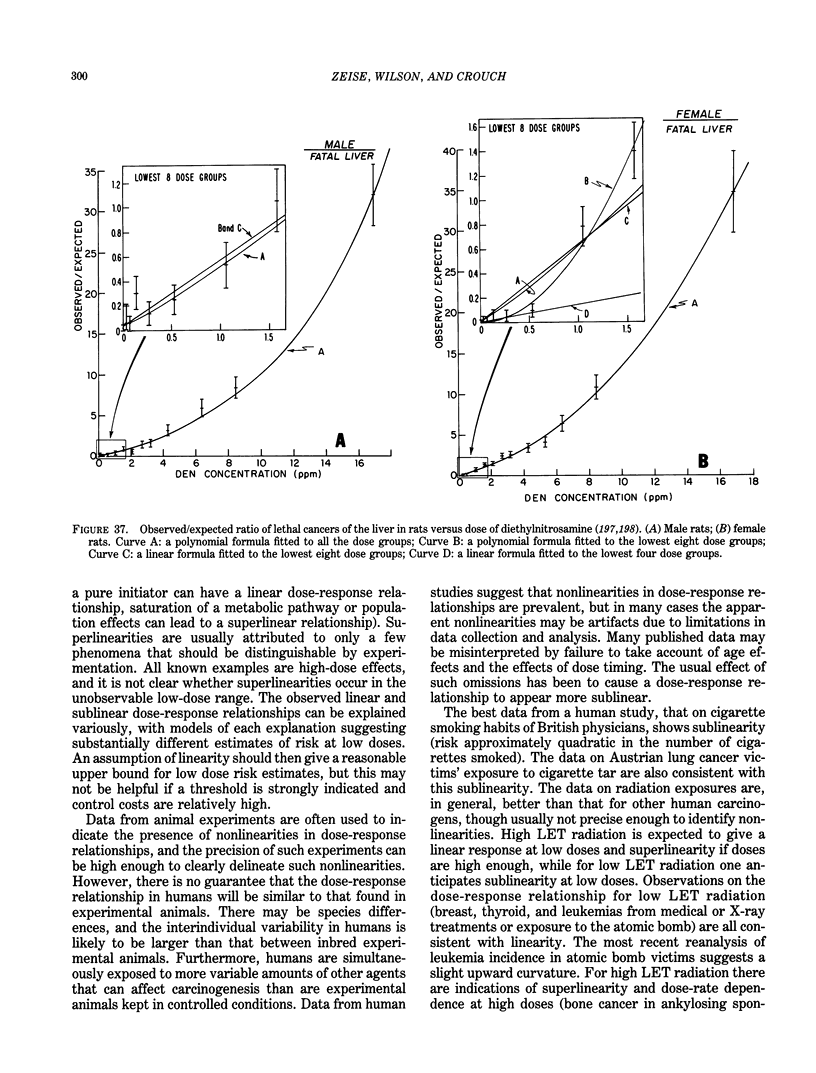

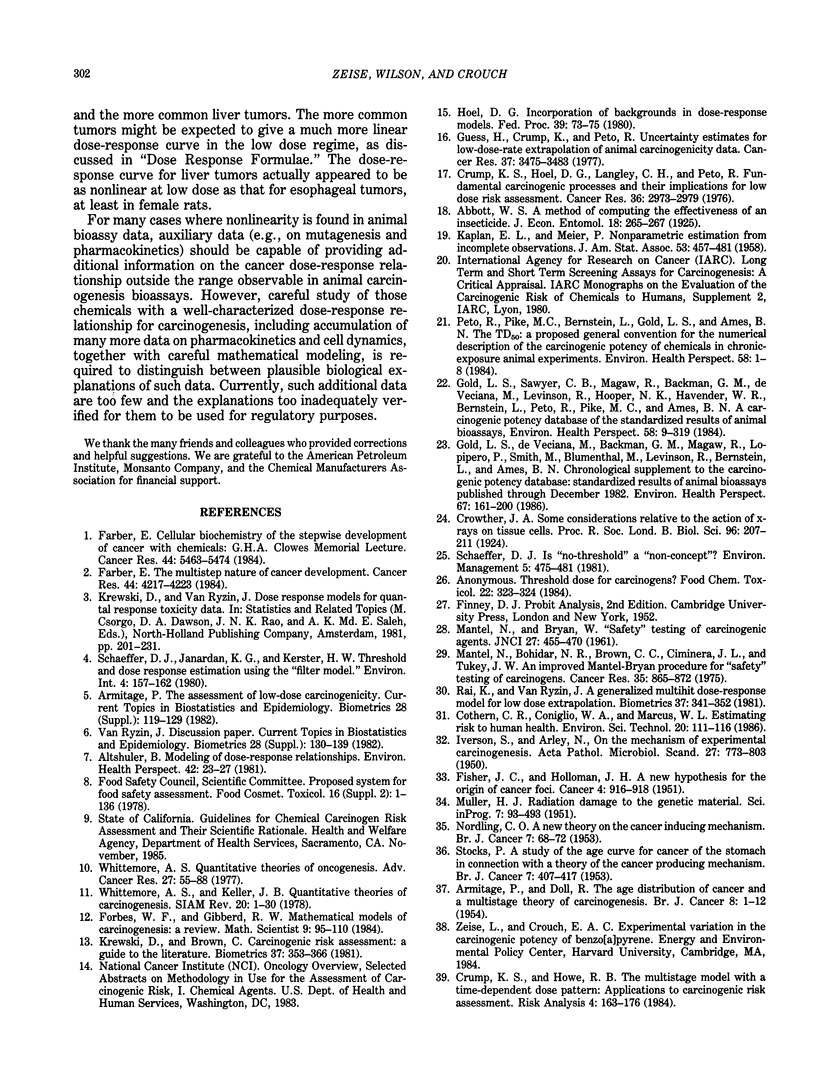
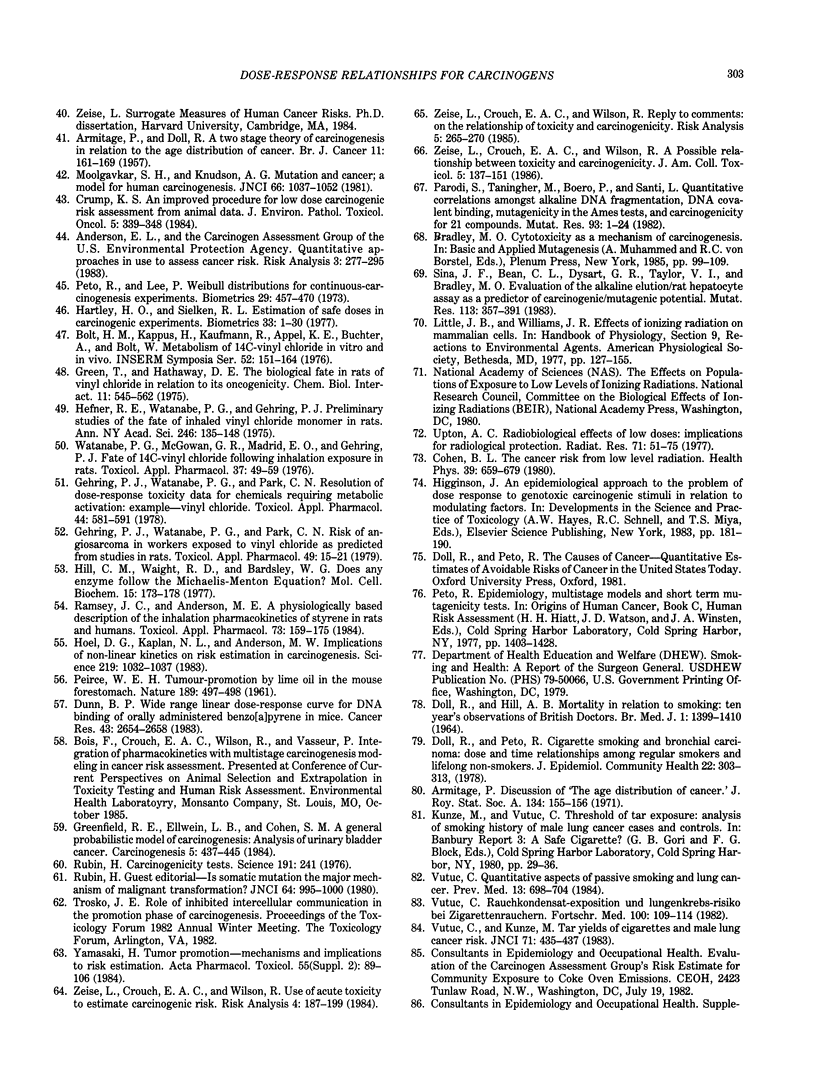
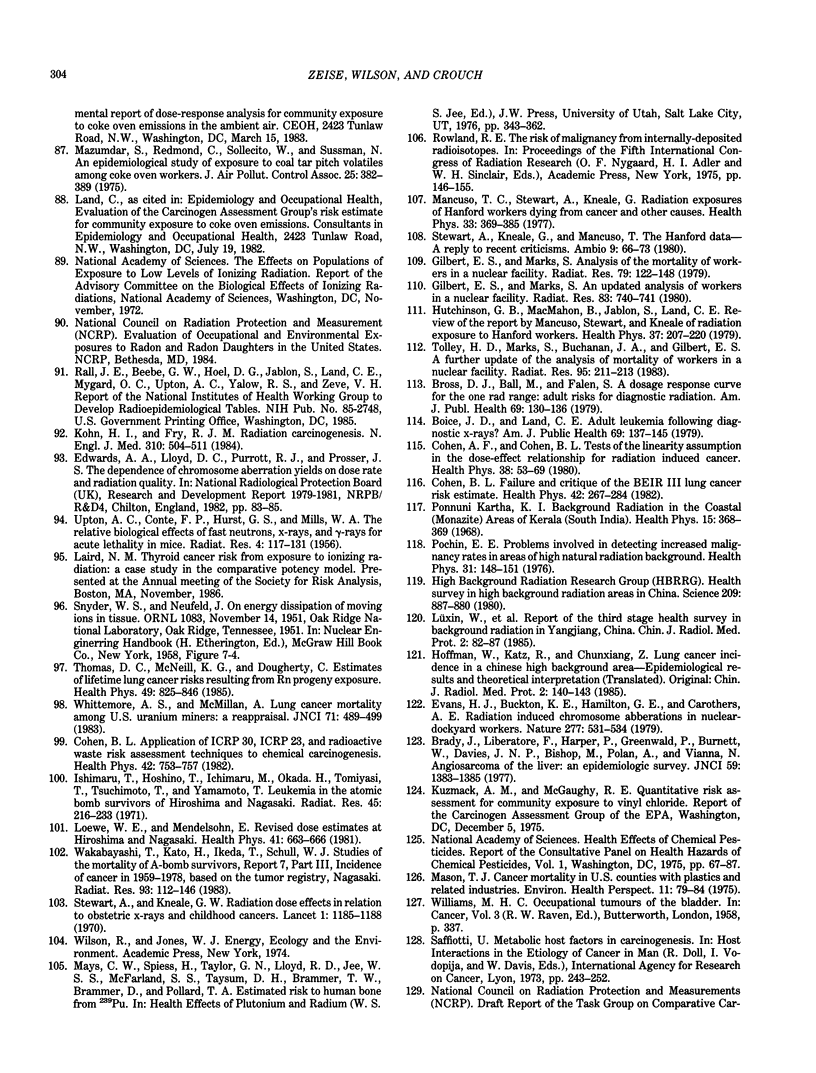
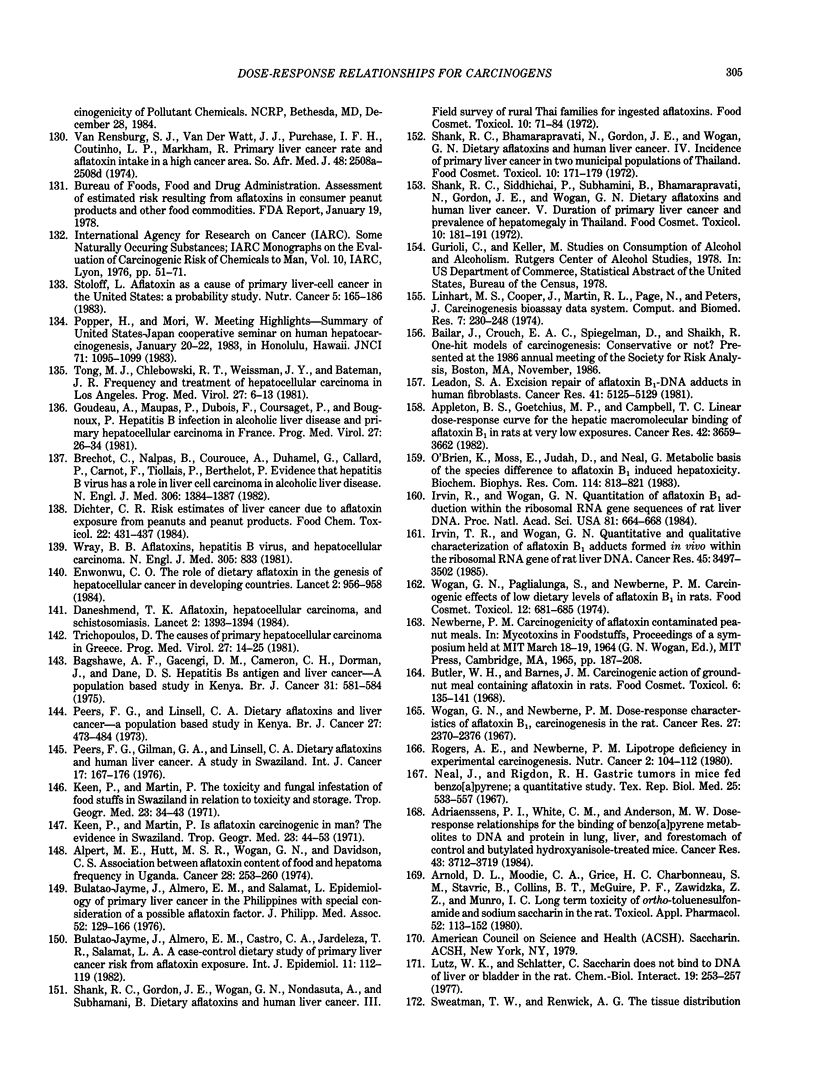
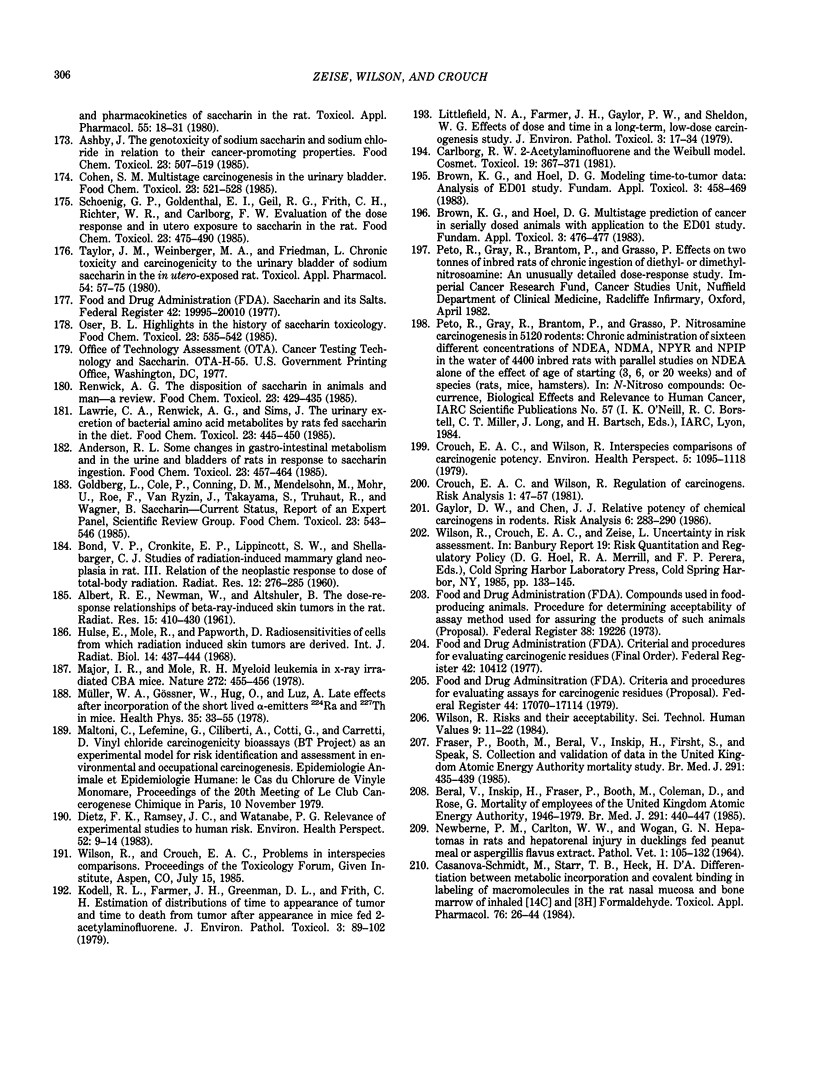
Selected References
These references are in PubMed. This may not be the complete list of references from this article.
- ALBERT R. E., NEWMAN W., ALTSHULER B. The doseresponse relationships of beta-ray induced skin tumors in the rat. Radiat Res. 1961 Sep;15:410–430. [PubMed] [Google Scholar]
- ARMITAGE P., DOLL R. A two-stage theory of carcinogenesis in relation to the age distribution of human cancer. Br J Cancer. 1957 Jun;11(2):161–169. doi: 10.1038/bjc.1957.22. [DOI] [PMC free article] [PubMed] [Google Scholar]
- ARMITAGE P., DOLL R. The age distribution of cancer and a multi-stage theory of carcinogenesis. Br J Cancer. 1954 Mar;8(1):1–12. doi: 10.1038/bjc.1954.1. [DOI] [PMC free article] [PubMed] [Google Scholar]
- Adriaenssens P. I., White C. M., Anderson M. W. Dose-response relationships for the binding of benzo(a)pyrene metabolites to DNA and protein in lung, liver, and forestomach of control and butylated hydroxyanisole-treated mice. Cancer Res. 1983 Aug;43(8):3712–3719. [PubMed] [Google Scholar]
- Alpert M. E., Hutt M. S., Wogan G. N., Davidson C. S. Association between aflatoxin content of food and hepatoma frequency in Uganda. Cancer. 1971 Jul;28(1):253–260. doi: 10.1002/1097-0142(197107)28:1<253::aid-cncr2820280151>3.0.co;2-g. [DOI] [PubMed] [Google Scholar]
- Altshuler B. Modeling of dose-response relationships. Environ Health Perspect. 1981 Dec;42:23–27. doi: 10.1289/ehp.814223. [DOI] [PMC free article] [PubMed] [Google Scholar]
- Anderson R. L. Some changes in gastro-intestinal metabolism and in the urine and bladders of rats in response to sodium saccharin ingestion. Food Chem Toxicol. 1985 Apr-May;23(4-5):457–463. doi: 10.1016/0278-6915(85)90140-1. [DOI] [PubMed] [Google Scholar]
- Appleton B. S., Goetchius M. P., Campbell T. C. Linear dose-response curve for the hepatic macromolecular binding of aflatoxin B1 in rats at very low exposures. Cancer Res. 1982 Sep;42(9):3659–3662. [PubMed] [Google Scholar]
- Armitage P. The assessment of low-dose carcinogenicity. Biometrics. 1982 Mar;38 (Suppl):119–139. [PubMed] [Google Scholar]
- Arnold D. L., Moodie C. A., Grice H. C., Charbonneau S. M., Stavric B., Collins B. T., McGuire P. F., Zawidzka Z. Z., Munro I. C. Long-term toxicity of ortho-touenesulfonamide and sodium saccharin in the rat. Toxicol Appl Pharmacol. 1980 Jan;52(1):113–152. doi: 10.1016/0041-008x(80)90253-7. [DOI] [PubMed] [Google Scholar]
- Ashby J. The genotoxicity of sodium saccharin and sodium chloride in relation to their cancer-promoting properties. Food Chem Toxicol. 1985 Apr-May;23(4-5):507–519. doi: 10.1016/0278-6915(85)90145-0. [DOI] [PubMed] [Google Scholar]
- BOND V. P., CRONKITE E. P., LIPPINCOTT S. W., SHELLABARGER C. J. Studies on radiation-induced mammary gland neoplasia in the rat. III. Relation of the neoplastic response to dose of total-body radiation. Radiat Res. 1960 Mar;12:276–285. [PubMed] [Google Scholar]
- Bagshawe A. F., Gacengi D. M., Cameron C. H., Dorman J., Dane D. S. Hepatitis Bs antigen and liver cancer: A population based study in Kenya. Br J Cancer. 1975 May;31(5):581–584. doi: 10.1038/bjc.1975.99. [DOI] [PMC free article] [PubMed] [Google Scholar]
- Beral V., Inskip H., Fraser P., Booth M., Coleman D., Rose G. Mortality of employees of the United Kingdom Atomic Energy Authority, 1946-1979. Br Med J (Clin Res Ed) 1985 Aug 17;291(6493):440–447. doi: 10.1136/bmj.291.6493.440. [DOI] [PMC free article] [PubMed] [Google Scholar]
- Boice J. D., Land C. E. Adult leukemia following diagnostic x-rays? (Review of report by BROSS, BALL, and FALEN on a tri-state leukemia survey). Am J Public Health. 1979 Feb;69(2):137–145. doi: 10.2105/ajph.69.2.137. [DOI] [PMC free article] [PubMed] [Google Scholar]
- Brady J., Liberatore F., Harper P., Greenwald P., Burnett W., Davies J. N., Bishop M., Polan A., Vianna N. Angiosarcoma of the liver: an epidemiologic survey. J Natl Cancer Inst. 1977 Nov;59(5):1383–1385. doi: 10.1093/jnci/59.5.1383. [DOI] [PubMed] [Google Scholar]
- Bross I. D., Ball M., Falen S. A dosage response curve for the one rad range: adult risks from diagnostic radiation. Am J Public Health. 1979 Feb;69(2):130–136. doi: 10.2105/ajph.69.2.130. [DOI] [PMC free article] [PubMed] [Google Scholar]
- Brown K. G., Hoel D. G. Modeling time-to-tumor data: analysis of the ED01 study. Fundam Appl Toxicol. 1983 Sep-Oct;3(5):458–469. doi: 10.1016/s0272-0590(83)80021-9. [DOI] [PubMed] [Google Scholar]
- Brown K. G., Hoel D. G. Multistage prediction of cancer in serially dosed animals with application to the ED01 study. Fundam Appl Toxicol. 1983 Sep-Oct;3(5):470–477. doi: 10.1016/s0272-0590(83)80022-0. [DOI] [PubMed] [Google Scholar]
- Bréchot C., Nalpas B., Couroucé A. M., Duhamel G., Callard P., Carnot F., Tiollais P., Berthelot P. Evidence that hepatitis B virus has a role in liver-cell carcinoma in alcoholic liver disease. N Engl J Med. 1982 Jun 10;306(23):1384–1387. doi: 10.1056/NEJM198206103062302. [DOI] [PubMed] [Google Scholar]
- Bulatao-Jayme J., Almero E. M., Castro M. C., Jardeleza M. T., Salamat L. A. A case-control dietary study of primary liver cancer risk from aflatoxin exposure. Int J Epidemiol. 1982 Jun;11(2):112–119. doi: 10.1093/ije/11.2.112. [DOI] [PubMed] [Google Scholar]
- Butler W. H., Barnes J. M. Carcinogenic action of groundnut meal containing aflatoxin in rats. Food Cosmet Toxicol. 1968 Aug;6(2):135–141. doi: 10.1016/0015-6264(68)90194-6. [DOI] [PubMed] [Google Scholar]
- Carlborg F. W. 2-acetylaminofluorene and the Weibull model. Food Cosmet Toxicol. 1981 Jun;19(3):367–371. doi: 10.1016/0015-6264(81)90398-9. [DOI] [PubMed] [Google Scholar]
- Casanova-Schmitz M., Starr T. B., Heck H. D. Differentiation between metabolic incorporation and covalent binding in the labeling of macromolecules in the rat nasal mucosa and bone marrow by inhaled [14C]- and [3H]formaldehyde. Toxicol Appl Pharmacol. 1984 Oct;76(1):26–44. doi: 10.1016/0041-008x(84)90026-7. [DOI] [PubMed] [Google Scholar]
- Cohen A. F., Cohen B. L. Tests of the linearity assumption in the dose-effect relationship for radiation-induced cancer. Health Phys. 1980 Jan;38(1):53–69. doi: 10.1097/00004032-198001000-00006. [DOI] [PubMed] [Google Scholar]
- Cohen B. L. Applications of ICRP 30, ICRP 23, and radioactive waste risk assessment techniques to chemical carcinogens. Health Phys. 1982 Jun;42(6):753–757. doi: 10.1097/00004032-198206000-00001. [DOI] [PubMed] [Google Scholar]
- Cohen B. L. Failures and critique of the BEIR III lung cancer risk estimates. Health Phys. 1982 Mar;42(3):267–284. doi: 10.1097/00004032-198203000-00002. [DOI] [PubMed] [Google Scholar]
- Cohen B. L. The cancer risk from low-level radiation. Health Phys. 1980 Oct;39(4):659–678. doi: 10.1097/00004032-198010000-00008. [DOI] [PubMed] [Google Scholar]
- Cohen S. M. Multi-stage carcinogenesis in the urinary bladder. Food Chem Toxicol. 1985 Apr-May;23(4-5):521–528. doi: 10.1016/0278-6915(85)90146-2. [DOI] [PubMed] [Google Scholar]
- Crouch E., Wilson R. Interspecies comparison of carcionogenic potency. J Toxicol Environ Health. 1979 Nov;5(6):1095–1118. doi: 10.1080/15287397909529817. [DOI] [PubMed] [Google Scholar]
- Crump K. S. An improved procedure for low-dose carcinogenic risk assessment from animal data. J Environ Pathol Toxicol Oncol. 1984 Jul;5(4-5):339–348. [PubMed] [Google Scholar]
- Crump K. S., Hoel D. G., Langley C. H., Peto R. Fundamental carcinogenic processes and their implications for low dose risk assessment. Cancer Res. 1976 Sep;36(9 PT1):2973–2979. [PubMed] [Google Scholar]
- DOLL R., HILL A. B. MORTALITY IN RELATION TO SMOKING: TEN YEARS' OBSERVATIONS OF BRITISH DOCTORS. Br Med J. 1964 May 30;1(5395):1399–1410. doi: 10.1136/bmj.1.5395.1399. [DOI] [PMC free article] [PubMed] [Google Scholar]
- Daneshmend T. K. Aflatoxin, hepatocellular carcinoma, and schistosomiasis. Lancet. 1984 Dec 15;2(8416):1393–1394. doi: 10.1016/s0140-6736(84)92082-8. [DOI] [PubMed] [Google Scholar]
- Dichter C. R. Risk estimates of liver cancer due to aflatoxin exposure from peanuts and peanut products. Food Chem Toxicol. 1984 Jun;22(6):431–437. doi: 10.1016/0278-6915(84)90325-9. [DOI] [PubMed] [Google Scholar]
- Dietz F. K., Ramsey J. C., Watanabe P. G. Relevance of experimental studies to human risk. Environ Health Perspect. 1983 Oct;52:9–14. doi: 10.1289/ehp.83529. [DOI] [PMC free article] [PubMed] [Google Scholar]
- Dunn B. P. Wide-range linear dose-response curve for DNA binding of orally administered benzo(a)pyrene in mice. Cancer Res. 1983 Jun;43(6):2654–2658. [PubMed] [Google Scholar]
- Enwonwu C. O. The role of dietary aflatoxin in the genesis of hepatocellular cancer in developing countries. Lancet. 1984 Oct 27;2(8409):956–958. doi: 10.1016/s0140-6736(84)91168-1. [DOI] [PubMed] [Google Scholar]
- Evans H. J., Buckton K. E., Hamilton G. E., Carothers A. Radiation-induced chromosome aberrations in nuclear-dockyard workers. Nature. 1979 Feb 15;277(5697):531–534. doi: 10.1038/277531a0. [DOI] [PubMed] [Google Scholar]
- FISHER J. C., HOLLOMON J. H. A hypothesis for the origin of cancer foci. Cancer. 1951 Sep;4(5):916–918. doi: 10.1002/1097-0142(195109)4:5<916::aid-cncr2820040504>3.0.co;2-7. [DOI] [PubMed] [Google Scholar]
- Farber E. Cellular biochemistry of the stepwise development of cancer with chemicals: G. H. A. Clowes memorial lecture. Cancer Res. 1984 Dec;44(12 Pt 1):5463–5474. [PubMed] [Google Scholar]
- Farber E. The multistep nature of cancer development. Cancer Res. 1984 Oct;44(10):4217–4223. [PubMed] [Google Scholar]
- Fraser P., Booth M., Beral V., Inskip H., Firsht S., Speak S. Collection and validation of data in the United Kingdom Atomic Energy Authority mortality study. Br Med J (Clin Res Ed) 1985 Aug 17;291(6493):435–439. doi: 10.1136/bmj.291.6493.435. [DOI] [PMC free article] [PubMed] [Google Scholar]
- Gaylor D. W., Chen J. J. Relative potency of chemical carcinogens in rodents. Risk Anal. 1986 Sep;6(3):283–290. doi: 10.1111/j.1539-6924.1986.tb00220.x. [DOI] [PubMed] [Google Scholar]
- Gehring P. J., Watanabe P. G., Park C. N. Resolution of dose-response toxicity data for chemicals requiring metabolic activation: example--vinyl chloride. Toxicol Appl Pharmacol. 1978 Jun;44(3):581–591. doi: 10.1016/0041-008x(78)90266-1. [DOI] [PubMed] [Google Scholar]
- Gehring P. J., Watanabe P. G., Park C. N. Risk of angiosarcoma in workers exposed to vinyl chloride as predicted from studies in rats. Toxicol Appl Pharmacol. 1979 Jun 15;49(1):15–21. doi: 10.1016/0041-008x(79)90271-0. [DOI] [PubMed] [Google Scholar]
- Gilbert E. S., Marks S. An analysis of the mortality of workers in a nuclear facility. Radiat Res. 1979 Jul;79(1):122–148. [PubMed] [Google Scholar]
- Gilbert E. S., Marks S. An updated analysis of mortality of workers in a nuclear facility. Radiat Res. 1980 Sep;83(3):740–741. [PubMed] [Google Scholar]
- Gold L. S., Sawyer C. B., Magaw R., Backman G. M., de Veciana M., Levinson R., Hooper N. K., Havender W. R., Bernstein L., Peto R. A carcinogenic potency database of the standardized results of animal bioassays. Environ Health Perspect. 1984 Dec;58:9–319. doi: 10.1289/ehp.84589. [DOI] [PMC free article] [PubMed] [Google Scholar]
- Gold L. S., de Veciana M., Backman G. M., Magaw R., Lopipero P., Smith M., Blumenthal M., Levinson R., Bernstein L., Ames B. N. Chronological supplement to the Carcinogenic Potency Database: standardized results of animal bioassays published through December 1982. Environ Health Perspect. 1986 Aug;67:161–200. doi: 10.1289/ehp.8667161. [DOI] [PMC free article] [PubMed] [Google Scholar]
- Goudeau A., Maupas P., Dubois F., Coursaget P., Bougnoux P. Hepatitis B infection in alcoholic liver disease and primary hepatocellular carcinoma in France. Prog Med Virol. 1981;27:26–34. [PubMed] [Google Scholar]
- Green T., Hathway D. E. The biological fate in rats of vinyl chloride in relation to its oncogenicity. Chem Biol Interact. 1975 Dec;11(6):545–562. doi: 10.1016/0009-2797(75)90030-7. [DOI] [PubMed] [Google Scholar]
- Greenfield R. E., Ellwein L. B., Cohen S. M. A general probabilistic model of carcinogenesis: analysis of experimental urinary bladder cancer. Carcinogenesis. 1984 Apr;5(4):437–445. doi: 10.1093/carcin/5.4.437. [DOI] [PubMed] [Google Scholar]
- Guess H., Crump K., Peto R. Uncertainty estimates for low-dose-rate extrapolations of animal carcinogenicity data. Cancer Res. 1977 Oct;37(10):3475–3483. [PubMed] [Google Scholar]
- Hartley H. O., Sielken R. L., Jr Estimation of "safe doses" in carcinogenic experiments. Biometrics. 1977 Mar;33(1):1–30. [PubMed] [Google Scholar]
- Higginson J. An epidemiological approach to the problem of dose responses to genotoxic carcinogenic stimuli in relation to modulating factors. Dev Toxicol Environ Sci. 1983;11:181–190. [PubMed] [Google Scholar]
- Hill C. M., Waight R. D., Bardsley W. G. Dose any enzyme follow the Michaelis-Menten equation? Mol Cell Biochem. 1977 May 3;15(3):173–178. doi: 10.1007/BF01734107. [DOI] [PubMed] [Google Scholar]
- Hoel D. G. Incorporation of background in dose-response models. Fed Proc. 1980 Jan;39(1):73–75. [PubMed] [Google Scholar]
- Hoel D. G., Kaplan N. L., Anderson M. W. Implication of nonlinear kinetics on risk estimation in carcinogenesis. Science. 1983 Mar 4;219(4588):1032–1037. doi: 10.1126/science.6823565. [DOI] [PubMed] [Google Scholar]
- Hulse E. V., Mole R. H., Papworth D. G. Radiosensitivities of cells from which radiation-induced skin tumours are derived. Int J Radiat Biol Relat Stud Phys Chem Med. 1968;14(5):437–444. doi: 10.1080/09553006814551321. [DOI] [PubMed] [Google Scholar]
- Hutchison G. B., MacMahon B., Jablon S., Land C. E. Review of report by Mancuso, Stewart and Kneale of radiation exposure of Hanford workers. Health Phys. 1979 Aug;37(2):207–220. doi: 10.1097/00004032-197908000-00003. [DOI] [PubMed] [Google Scholar]
- Irvin T. R., Wogan G. N. Quantitation of aflatoxin B1 adduction within the ribosomal RNA gene sequences of rat liver DNA. Proc Natl Acad Sci U S A. 1984 Feb;81(3):664–668. doi: 10.1073/pnas.81.3.664. [DOI] [PMC free article] [PubMed] [Google Scholar]
- Irvin T. R., Wogan G. N. Quantitative and qualitative characterization of aflatoxin B1 adducts formed in vivo within the ribosomal RNA genes of rat liver DNA. Cancer Res. 1985 Aug;45(8):3497–3502. [PubMed] [Google Scholar]
- Ishimaru T., Hoshino T., Ichimaru M., Okada H., Tomiyasu T. Leukemia in atomic bomb survivors, Hiroshima and Nagasaki, 1 October 1950--30 September 1966. Radiat Res. 1971 Jan;45(1):216–233. [PubMed] [Google Scholar]
- Kartha K. I. Background radiation in the coastal (monazite) areas of Kerala (South India). Health Phys. 1968 Oct;15(4):368–369. [PubMed] [Google Scholar]
- Keen P., Martin P. Is aflatoxin carcinogenic in man? The evidence in Swaziland. Trop Geogr Med. 1971 Mar;23(1):44–53. [PubMed] [Google Scholar]
- Kodell R. L., Farmer J. H., Greenman D. L., Frith C. H. Estimation of distributions of time to appearance of tumor and time to death from tumor after appearance in mice fed 2-acetylaminofluorene. J Environ Pathol Toxicol. 1980;3(3 Spec No):89–102. [PubMed] [Google Scholar]
- Kohn H. I., Fry R. J. Radiation carcinogenesis. N Engl J Med. 1984 Feb 23;310(8):504–511. doi: 10.1056/NEJM198402233100807. [DOI] [PubMed] [Google Scholar]
- Krewski D., Brown C. Carcinogenic risk assessment: a guide to the literature. Biometrics. 1981 Jun;37(2):353–366. [PubMed] [Google Scholar]
- Lawrie C. A., Renwick A. G., Sims J. The urinary excretion of bacterial amino-acid metabolites by rats fed saccharin in the diet. Food Chem Toxicol. 1985 Apr-May;23(4-5):445–450. doi: 10.1016/0278-6915(85)90138-3. [DOI] [PubMed] [Google Scholar]
- Leadon S. A., Tyrrell R. M., Cerutti P. A. Excision repair of aflatoxin B1-DNA adducts in human fibroblasts. Cancer Res. 1981 Dec;41(12 Pt 1):5125–5129. [PubMed] [Google Scholar]
- Linhart M. S., Cooper J., Martin R. L., Page N., Peters J. Carcinogenesis bioassay data system. Comput Biomed Res. 1974 Jun;7(3):230–248. doi: 10.1016/0010-4809(74)90004-4. [DOI] [PubMed] [Google Scholar]
- Littlefield N. A., Farmer J. H., Gaylor D. W., Sheldon W. G. Effects of dose and time in a long-term, low-dose carcinogenic study. J Environ Pathol Toxicol. 1980;3(3 Spec No):17–34. [PubMed] [Google Scholar]
- Loewe W. E., Mendelsohn E. Revised dose estimates at Hiroshima and Nagasaki. Health Phys. 1981 Oct;41(4):663–666. [PubMed] [Google Scholar]
- Lutz W. K., Schlatter C. Saccharin does not bind to DNA of liver or bladder in the rat. Chem Biol Interact. 1977 Nov;19(2):253–257. doi: 10.1016/0009-2797(77)90036-9. [DOI] [PubMed] [Google Scholar]
- MANTEL N., BRYAN W. R. "Safety" testing of carcinogenic agents. J Natl Cancer Inst. 1961 Aug;27:455–470. [PubMed] [Google Scholar]
- Major I. R., Mole R. H. Myeloid leukaemia in x-ray irradiated CBA mice. Nature. 1978 Mar 30;272(5652):455–456. doi: 10.1038/272455a0. [DOI] [PubMed] [Google Scholar]
- Mancuso T. F., Stewart A., Kneale G. Radiation exposures of Hanford workers dying from cancer and other causes. Health Phys. 1977 Nov;33:369–385. doi: 10.1097/00004032-197711000-00002. [DOI] [PubMed] [Google Scholar]
- Mantel N., Bohidar N. R., Brown C. C., Ciminera J. L., Tukey J. W. An improved Mantel-Bryan procedure for "safety" testing of carcinogens. Cancer Res. 1975 Apr;35(4):865–872. [PubMed] [Google Scholar]
- Mason T. J. Cancer mortality in U.S. counties with plastics and related industries. Environ Health Perspect. 1975 Jun;11:79–84. doi: 10.1289/ehp.751179. [DOI] [PMC free article] [PubMed] [Google Scholar]
- Moolgavkar S. H., Knudson A. G., Jr Mutation and cancer: a model for human carcinogenesis. J Natl Cancer Inst. 1981 Jun;66(6):1037–1052. doi: 10.1093/jnci/66.6.1037. [DOI] [PubMed] [Google Scholar]
- Müller W. A., Gössner W., Hug O., Luz A. Late effects after incorporation of the short-lived alpha-emitters 224Ra and 227Th in mice. Health Phys. 1978 Jul;35(1):33–55. doi: 10.1097/00004032-197807000-00004. [DOI] [PubMed] [Google Scholar]
- NORDLING C. O. A new theory on cancer-inducing mechanism. Br J Cancer. 1953 Mar;7(1):68–72. doi: 10.1038/bjc.1953.8. [DOI] [PMC free article] [PubMed] [Google Scholar]
- Neal J., Rigdon R. H. Gastric tumors in mice fed benzo(a)pyrene: a quantitative study. Tex Rep Biol Med. 1967 Winter;25(4):553–557. [PubMed] [Google Scholar]
- O'Brien K., Moss E., Judah D., Neal G. Metabolic basis of the species difference to aflatoxin B1 induced hepatotoxicity. Biochem Biophys Res Commun. 1983 Jul 29;114(2):813–821. doi: 10.1016/0006-291x(83)90854-9. [DOI] [PubMed] [Google Scholar]
- Oser B. L. Highlights in the history of saccharin toxicology. Food Chem Toxicol. 1985 Apr-May;23(4-5):535–542. doi: 10.1016/0278-6915(85)90148-6. [DOI] [PubMed] [Google Scholar]
- PEIRCE W. E. Tumour-promotion by lime oil in the mouse forestomach. Nature. 1961 Feb 11;189:497–498. doi: 10.1038/189497a0. [DOI] [PubMed] [Google Scholar]
- Parodi S., Taningher M., Boero P., Santi L. Quantitative correlations amongst alkaline DNA fragmentation, DNA covalent binding, mutagenicity in the Ames test and carcinogenicity, for 21 compounds. Mutat Res. 1982 Mar;93(1):1–24. doi: 10.1016/0027-5107(82)90121-x. [DOI] [PubMed] [Google Scholar]
- Peers F. G., Gilman G. A., Linsell C. A. Dietary aflatoxins and human liver cancer. A study in Swaziland. Int J Cancer. 1976 Feb 15;17(2):167–176. doi: 10.1002/ijc.2910170204. [DOI] [PubMed] [Google Scholar]
- Peers F. G., Linsell C. A. Dietary aflatoxins and liver cancer--a population based study in Kenya. Br J Cancer. 1973 Jun;27(6):473–484. doi: 10.1038/bjc.1973.60. [DOI] [PMC free article] [PubMed] [Google Scholar]
- Peto R., Lee P. Weibull distributions for continuous-carcinogenesis experiments. Biometrics. 1973 Sep;29(3):457–470. [PubMed] [Google Scholar]
- Pochin E. E. Problems involved in detecting increased malignancy rates in areas of high natural radiation background. Health Phys. 1976 Aug;31(2):148–151. [PubMed] [Google Scholar]
- Popper H., Mori W. Summary of United States--Japan Cooperative Seminar on Human Hepatocarcinogenesis, January 20-22, 1983, in Honolulu, Hawaii. J Natl Cancer Inst. 1983 Nov;71(5):1095–1099. [PubMed] [Google Scholar]
- Rai K., Van Ryzin J. A generalized multihit dose-response model for low-dose extrapolation. Biometrics. 1981 Jun;37(2):341–352. [PubMed] [Google Scholar]
- Ramsey J. C., Andersen M. E. A physiologically based description of the inhalation pharmacokinetics of styrene in rats and humans. Toxicol Appl Pharmacol. 1984 Mar 30;73(1):159–175. doi: 10.1016/0041-008x(84)90064-4. [DOI] [PubMed] [Google Scholar]
- Renwick A. G. The disposition of saccharin in animals and man--a review. Food Chem Toxicol. 1985 Apr-May;23(4-5):429–435. doi: 10.1016/0278-6915(85)90136-x. [DOI] [PubMed] [Google Scholar]
- Rubin H. Carcinogenicity tests. Science. 1976 Jan 23;191(4224):241–245. doi: 10.1126/science.191.4224.241-b. [DOI] [PubMed] [Google Scholar]
- Rubin H. Is somatic mutation the major mechanism of malignant transformation? J Natl Cancer Inst. 1980 May;64(5):995–1000. [PubMed] [Google Scholar]
- STOCKS P. A study of the age curve for cancer of the stomach in connection with a theory of the cancer producing mechanism. Br J Cancer. 1953 Dec;7(4):407–417. doi: 10.1038/bjc.1953.39. [DOI] [PMC free article] [PubMed] [Google Scholar]
- Schoenig G. P., Goldenthal E. I., Geil R. G., Frith C. H., Richter W. R., Carlborg F. W. Evaluation of the dose response and in utero exposure to saccharin in the rat. Food Chem Toxicol. 1985 Apr-May;23(4-5):475–490. doi: 10.1016/0278-6915(85)90142-5. [DOI] [PubMed] [Google Scholar]
- Shank R. C., Bhamarapravati N., Gordon J. E., Wogan G. N. Dietary aflatoxins and human liver cancer. IV. Incidence of primary liver cancer in two municipal populations of Thailand. Food Cosmet Toxicol. 1972 Apr;10(2):171–179. doi: 10.1016/s0015-6264(72)80195-0. [DOI] [PubMed] [Google Scholar]
- Shank R. C., Siddhichai P., Subhamani B., Bhamarapravati N., Gordon J. E., Wogan G. N. Dietary aflatoxins and human liver cancer. V. Duration of primary liver cancer and prevalence of hepatomegaly in Thailand. Food Cosmet Toxicol. 1972 Apr;10(2):181–191. doi: 10.1016/s0015-6264(72)80196-2. [DOI] [PubMed] [Google Scholar]
- Sina J. F., Bean C. L., Dysart G. R., Taylor V. I., Bradley M. O. Evaluation of the alkaline elution/rat hepatocyte assay as a predictor of carcinogenic/mutagenic potential. Mutat Res. 1983 Aug;113(5):357–391. doi: 10.1016/0165-1161(83)90228-5. [DOI] [PubMed] [Google Scholar]
- Stewart A., Kneale G. W. Radiation dose effects in relation to obstetric x-rays and childhood cancers. Lancet. 1970 Jun 6;1(7658):1185–1188. doi: 10.1016/s0140-6736(70)91782-4. [DOI] [PubMed] [Google Scholar]
- Stoloff L. Aflatoxin as a cause of primary liver-cell cancer in the United States: a probability study. Nutr Cancer. 1983;5(3-4):165–186. doi: 10.1080/01635588309513794. [DOI] [PubMed] [Google Scholar]
- Sweatman T. W., Renwick A. G. The tissue distribution and pharmacokinetics of saccharin in the rat. Toxicol Appl Pharmacol. 1980 Aug;55(1):18–31. doi: 10.1016/0041-008x(80)90215-x. [DOI] [PubMed] [Google Scholar]
- Taylor J. M., Weinberger M. A., Friedman L. Chronic toxicity and carcinogenicity to the urinary bladder of sodium saccharin in the in utero-exposed rat. Toxicol Appl Pharmacol. 1980 Jun 15;54(1):57–75. doi: 10.1016/0041-008x(80)90008-3. [DOI] [PubMed] [Google Scholar]
- Thomas D. C., McNeill K. G., Dougherty C. Estimates of lifetime lung cancer risks resulting from Rn progeny exposure. Health Phys. 1985 Nov;49(5):825–846. doi: 10.1097/00004032-198511000-00014. [DOI] [PubMed] [Google Scholar]
- Tolley H. D., Marks S., Buchanan J. A., Gilbert E. S. A further update of the analysis of mortality of workers in a nuclear facility. Radiat Res. 1983 Jul;95(1):211–213. [PubMed] [Google Scholar]
- Tong M. J., Chlebowski R. T., Weissman J. Y., Bateman J. R. Frequency and treatment of primary hepatocellular carcinoma in Los Angeles. Prog Med Virol. 1981;27:6–13. [PubMed] [Google Scholar]
- Trichopoulos D. The causes of primary hepatocellular carcinoma in Greece. Prog Med Virol. 1981;27:14–25. [PubMed] [Google Scholar]
- UPTON A. C., CONTE F. P., HURST G. S., MILLS W. A. The relative biological effectiveness of fast neutrons, x-rays, and gamma-rays for acute lethality in mice. Radiat Res. 1956 Feb;4(2):117–131. [PubMed] [Google Scholar]
- Upton A. C. Radiobiological effects of low doses. Implications for radiological protection. Radiat Res. 1977 Jul;71(1):51–74. [PubMed] [Google Scholar]
- Van Rensburg S. J., van der Watt J. J., Purchase I. F., Pereira Coutinho L., Markham R. Primary liver cancer rate and aflatoxin intake in a high cancer area. S Afr Med J. 1974 Dec 11;48(60):2508A–2508D. [PubMed] [Google Scholar]
- Vutuc C., Kunze M. Tar yields of cigarettes and male lung cancer risk. J Natl Cancer Inst. 1983 Sep;71(3):435–437. [PubMed] [Google Scholar]
- Vutuc C. Quantitative aspects of passive smoking and lung cancer. Prev Med. 1984 Nov;13(6):698–704. doi: 10.1016/s0091-7435(84)80019-5. [DOI] [PubMed] [Google Scholar]
- Vutuc C. Rauchkondensat-Exposition und Lungenkrebs-Risiko bei Zigarettenrauchern. Fortschr Med. 1982 Jan 28;100(4):109, 112-3. [PubMed] [Google Scholar]
- Wakabayashi T., Kato H., Ikeda T., Schull W. J. Studies of the mortality of A-bomb survivors, report 7. Part III. incidence of cancer in 1959-1978, based on the tumor registry, Nagasaki. Radiat Res. 1983 Jan;93(1):112–146. [PubMed] [Google Scholar]
- Watanabe P. G., McGowan G. R., Madrid E. O., Gehring P. J. Fate of [14C]vinyl chloride following inhalation exposure in rats. Toxicol Appl Pharmacol. 1976 Jul;37(1):49–59. doi: 10.1016/s0041-008x(76)80007-5. [DOI] [PubMed] [Google Scholar]
- Whittemore A. S., McMillan A. Lung cancer mortality among U.S. uranium miners: a reappraisal. J Natl Cancer Inst. 1983 Sep;71(3):489–499. [PubMed] [Google Scholar]
- Whittemore A. S. Quantitative theories of oncogenesis. Adv Cancer Res. 1978;27:55–88. doi: 10.1016/s0065-230x(08)60930-6. [DOI] [PubMed] [Google Scholar]
- Wogan G. N., Newberne P. M. Dose-response characteristics of aflatoxin B1 carcinogenesis in the rat. Cancer Res. 1967 Dec;27(12):2370–2376. [PubMed] [Google Scholar]
- Wogan G. N., Paglialunga S., Newberne P. M. Carcinogenic effects of low dietary levels of aflatoxin B1 in rats. Food Cosmet Toxicol. 1974 Oct;12(5-6):681–685. doi: 10.1016/0015-6264(74)90239-9. [DOI] [PubMed] [Google Scholar]
- Wray B. B. Aflatoxins, hepatitis B virus, and hepatocellular carcinoma. N Engl J Med. 1981 Oct 1;305(14):833–833. doi: 10.1056/NEJM198110013051416. [DOI] [PubMed] [Google Scholar]
- Yamasaki H. Tumor promotion--mechanisms and implication to risk estimation. Acta Pharmacol Toxicol (Copenh) 1984;55 (Suppl 2):89–106. doi: 10.1111/j.1600-0773.1984.tb02484.x. [DOI] [PubMed] [Google Scholar]
- Zeise L., Crouch E. A., Wilson R. On the relationship of toxicity and carcinogenicity. Risk Anal. 1985 Dec;5(4):265–270. doi: 10.1111/j.1539-6924.1985.tb00181.x. [DOI] [PubMed] [Google Scholar]


